Andalusia 2025
What is Stopping You From Moving to Málaga?
This month I got the opportunity to tick off Spain. I never seriously studied it - it had a brief moment of glory pumped by South American gold, but then fell off hard, so I never saw it as super important - nor does touristing for a few days give one any special insight into a country, so treat this as the modest collection of photos and off-hand observations that it is.
(1) The two places I visited were Granada (business, then the Alhambra) and Málaga (just tourism). This region of Andalusia is extremely scenic, combining Moorish and Christian architecture in a lush Mediterranean setting. However, it is also the poorest and lowest human capital region of Spain alongside Extremadura. Spain is known as degrowth central alongside Germany and the UK, and Andalusia in particular is a pronouncedly leftist region (though from what I understand leftism in Spain has more to do with regionalist resentments against Castilian dominance than overtly ideological stuff, bringing together rich atheist Catalans and rich liberal Basques with poor leftist-conservative Andalusians). I didn’t see extensive signs of politicization - not that I was looking for it - though I was amused to see a prominent poster in Granada agitating contra el turismo masivo. Not sure what their game plan is in the event they get their wish…
The flag test: Couple of rainbow flags, couple of Palestinian flags, no Israel or Ukraine flags (despite hosting many Ukrainian immigrants).
(2) Southern Spain is cheap - I’d say pretty much East European tier. (Just looked it up on Numbeo’s Cost of Living index: Málaga = Warsaw (and Moscow), so accurate). Train from Málaga to Granada is 24 Euros. Restaurants are cheap if you avoid the obvious tourist traps. I found one place (100 Montaditos at the Málaga train station) where a jamon and cheese sandwich was 2 Euros and a pint of beer was 1.5 Euros. That kind of price for beer I found impressive when I encountered it in Portugal in 2018 - to see it today in a First World country after seven years of inflation was astounding. Another place I paid 22 Euros for a 300 g entrecote steak.
Taxis and Ubers are the main things that are more expensive than in Eastern Europe. But rare exceptions like these aside, your cash goes a surprisingly long way here - far more so than I would have expected of a basically decent, walkable, and aesthetic locale with a prime Mediterranean climate. In retrospect, I’m guessing Andalusia’s peak may have been in the era before Brexit and the 2014 oil price collapse and the Ukraine War that rolled back globalization within Europe, back when British pensioners and upper-middle class Russians would buy up housing on the Spanish Mediterranean coast.
(3) There’s not much violent crime - not unless you’re a Russian traitor, I suppose - but petty crime is a well-known problem. The 16C villa our group initially stayed in was tended to by a Ukrainian groundskeeper. He explicitly warned us to close the gate at night because a car had been stolen from its premises a few years earlier.
Pickpocketing is said to be rife. I saw petty scammers collecting an “entrance fee” to a church that had no entry fee, and was accosted by Gypsy rosemary sellers and various hustlers offering to take a photo. Such low level hustles can be annoying, though obviously fall far short of the far more impressive grifterdom you see in Arab souks.
There’s certainly more litter on the streets and parks than in Northern Europe, if less so than in the Balkans, and much less so than in say Morocco. Pretty much analogous with Portugal’s Algarve (though I think there’s a bit less graffiti). All of this stuff including cleanliness and mundane grift is described by a gradient that goes from north and west to south and east with adjustments for local immigrant populations.
The other thing to bear in mind is that Spain is known for being a country that is very friendly to squatters. I assume that this - together with the lower level of function, modest local incomes, petty crime, and the fact that (I assume) most of the ambitious locals leave Andalusia for Madrid, Barcelona, or abroad - must explain the low local prices.
(4) Infrastructure is well developed. The roads are good, the trains are fast, the airport is sleek and glassy. Public transport in the cities seems comprehensive (that said you’re not going to have a good time long-term without a car). I’m assuming this is mostly thanks to EU gibs. That said, people overestimate the importance of infrastructure. One thing I noticed from my travels the past few years is that infrastructure is a solved problem in all but the most benighted places these days, even Morocco has a nice and functional railway system. The marginal benefits of going from good infrastructure to excellent infrastructure are meager and will not make you rich. For that you need to have, retain, or attract Elite Human Capital.
(5) The museums are open late by North European standards - until 7 pm, 8 pm, sometimes even 9 pm. The restaurants are typically open until 11 pm - 2 am. As a late sleeper and late riser, I appreciate this.
(6) Some random intersections between Spain and Eastern Europe (this is of course a well-established genre since at least 19C):
Murals of girls on buildings is one of the most amusing intersections between Slavic and Hispanic culture.
Ensalada rusa (unlike the Russian olivier - though the Spanish include a lot of seafood).
I saw a few Black human billboards outside pubs/restaurants LMAO. I had previously assumed it was just a quaint and somewhat boorish East European (or Russian) thing but it seems the Andalusians are still at something that would shock mainstream US Republicans. It goes to show that leftist/rightist binaries are often very fluid and contingent things.
Lazy bureaucrats (offices close at 2 pm) and extensive bureaucracy (e.g. need passports to enter some museums).
(7) Two days is enough to more or less comprehensively see Málaga (one for the Alcazaba; the other for the museums) and Granada (one for the Alhambra; one for the museums) individually. I would have loved to stay longer and for the sake of completionism also tick off Seville, Córdoba, Cádiz, and Gibraltar, but that was not an option this time round so will have to wait for some other time.
Granada
Granada was the capital of the Emirate of Granada from 1250, often paying tribute as a vassal state to the Castille until Ferdinand II and Isabella I finally put it out of its misery in 1492.
It was the most Islamicized part of the Iberian peninsula. Moorish architecture with its riot of arches and arabesques visually dominates the city, albeit leavened with classical Christian Mediterranean motifs such as niches housing statuettes of saints and azulejo street signs.
Some mosques were christianized through conversion to churches, such as the Iglesia Parroquial de Nuestro Salvador. This makes for a curious contrast from the usual pattern of Christian buildings having been Islamicized, such as the Hagia Sophia in Turkey.
The Alhambra
The Alhambra was far more impressive than anything I saw in Turkey or Morocco. I am not talking so much of the riyads (Islamic gardens) with their complex hydroponics, and the intricacy of constructions like the 14C Dome of the Two Sisters which holds the world record for the number of muqarnas, the stalactite-like ornamental vaultings decorating the Alhambra’s many domes - though they are impressive enough. But something that’s related and I suspect strongly intercorrelated with this complexity are the experiments with stained glass and pictorial representations of humans in ceiling murals painted sometime between 1395-1424), which represent an unusual openness to Christian borrowings and in the case of the latter even a certain degree of independence from Islamic orthodoxy that was most certainly extremely unusual by the standards of medieval Islamic polities.
Andalusia was undoubtedly the most Elite Human Capital-loaded medieval Muslim polity. It had Europe’s biggest early medieval cities, with Córdoba at one point even flipping Constantinople; it had early science, and an unusual degree of religious toleration). OTOH, it got conquered, so was being more EHC even worth it? Then again, its modern descendants live far better than than any Muslim region without oil, so one can say it worked out in the long run.
I have tried to move away from including too many photos in my Travel reports after jumping the shark on Romania (~300). But allow me to indulge myself here.
The Hall of the Ambassadors is above, where Isabella I and Ferdinand II received Columbus in 1492 prior to his voyage to the New World.
Would this make it the single most consequential location of the past millennium?
The main palace complex is the Nasrid Palace, which is protected by the Alcazaba fortress. The Generalife is a summer retreat constructed in the last century of the Emirate to serve as a summer retreat for the Nasrid rulers.
The belltower at the Torre de la Vela, the Tower of the Candle and highest point of the complex, was traditionally wrung by unwed maidens once a year on January 2, the anniversary of Granada’s conquest. It was said to guarantee she found a marriage partner within the year.
Below are some more views from this tower:
The Gate of Justice at the exit features an engraving of a hand (khamsa) at the outer arch, representing protection against evil, and an engraving of a key within the inner arch, representing authority and sovereignty. There was a prophecy that the day the hand reaches down and grasps the key, the fortress will fall. I suppose that is one prophecy that failed - the Alhambra fell, but the hand and key are still separated. Perhaps this can serve as inspiration for some fantasy writer.
Granada Cathedral
This is a Renaissance-style cathedral built at the site of Granada’s main mosque (destroyed). Construction began in 1523, and was completed in 1704.
Typical Catholic cathedral with gold, statues, various expensive trinkets such as an 18C English clock with Chinese motifs.
There is a memorial plaque listing local priests executed under the Republicans during the Spanish Civil War. Many of these were set up following the Francoist victory.
There’s an amusingly politically incorrect sculpture of Philip III trampling a Moorish soldier with his warhorse. It commemorates the final expulsion of the Moriscos - Muslims who had converted to Christianity - from Spain in 1609, ordered by Philip III.
The adjoining Chapel holds the tombs of Ferdinand II and Isabella I. It also has some historical artifacts and is otherwise unremarkable.
The Iglesia del Sagrario is part of the complex and is basically just a converted Moorish mosque.
Granada Archaeology Museum
The Granada Archaeology Museum is a state run museum with two main interesting objects:
Hominid molar from 1,400,000 BC, making it amongst the oldest human fossils in Europe.
Astrolabe of Ibn Zawal, constructed in 1481, is one of only 40 astrolabes that still remain in the world. Of these, 24 are in Spain and 9 are Muslim instruments. This astrolabe was the only one built specifically for Granada’s latitude.
Cuevas del Sacromonte
In the hills above Granada there are cave formations that have been interminably used across the centuries as bandit hideouts, refuges from state persecution (Black slaves; Gypsies), and more recently, cheap living quarters for the flood of rural laborers that flooded into the overcrowded cities when local urbanization took off in the 1950s.
This small, picturesque museum illustrates the folkways of these cave denizens across the centuries.
The living quarters had a Singer machine. Because of course - where can you NOT find Singer machines? That ultimate symbol of the first industrial globalization. Someone should write a book on them.
There’s an amusing story/legend about how this region came to be bknown as Blackmen’s Gully:
The legend says that after Granada was conquered by the Catholic King and Queen, many Arab noblemen fled to Africa. In their hearts they hoped that one day they would return to the city where they had lived, were their grandparents and parents had grown up and their children had been born.
Afraid of being attacked and robbed of their riches by “renegades of the Christian troops” on their way to the ports of Almería or Almuñécar, they hid their fortunes in holes under the olive trees which once covered these hills.
When they fled, they left behind their slaves, many of which were Black Africans, because it was slower and more expensive to travel with a crowd. These slaves knew of their masters’ concerns about their money and had noticed their comings and goings to and from Valparaiso (“valley of Paradise”, as Sacromonte was then called). So they made a plan: now that they were free, but without home nor income, they would go to Valparaiso and dig and dig until they found their former masters’ treasures.
So they dug and dug into the hillsides of this gully, but without success (as far as we know). Exhausted by the efforts and not having any other shelter, they stayed in the holes they had dug looking for the treasures. As time went on they made their home in these caves. And that is how this area got its name, Blackmen’s Gully.
The legend goes on to say that some generations later, when the black inhabitants of this gully had already mixed with the Gypsies, magic charms were used to find out where the treasures could be. It was said that an old sorceress could tell where they were hidden by talking with water and fire and looking and blinking onto a surface of water. We don’t know if the lost treasures were found and secretly kept by someone advised by the sorceress, or if they are still hidden somewhere in this area, maybe very near to where you are now standing.
Palace of the Forgotten
The Palace of the Forgotten contains a flamenco theater and some expositions on the Inquisition and its torture instruments. Such museums are usually more about sensationalism than authenticity, and this was true here as well; the chastity belt was on display as one of the Inquisition’s supposed instruments, but we know that it was pretty much entirely the invention of Victorian erotic fantasists.
But very amusing nonetheless to see Spaniards reverse colonize themselves with the Black Legend.
Monasterio de San Jerónimo
Quaint, placid Catholic monastery built in 16C with a big courtyard orchard with orange trees. It now serves as a nunnery.
It hosts the burial place of Gonzalo Fernández de Córdoba, the “Great Captain”, noted military innovator and conqueror of Granada.
Málaga
Málaga has a metropolitan population of about a million and is Andalusia’s biggest coastal resort-city. Founded by the Phoenicians, it has been an economic hub for millennia, in particular serving as a center of garum production during the Roman era. This industrial theme continues through to today, with the industrial seaport being something of an eyesore amidst the beaches and 19C architecture.
Unsurprisingly, it is popular with tourists. That said, people coming for longer stays - pensioners and remote workers camping over the winter months are a prominent demographic - would probably be best advised to move to some cheaper and more scenic locale, such as La Herradura or Almeria.
Here are some street scenes from Málaga:
The Alcazaba
The Alcazaba is the palatial fort of Málaga. Originating as a Phoenician fort, its current core form took shape in 11C. Later Nasrid rulers added the palace quarters and a higher fort, the Gibralfaro, in 14C.
The interiors are modest, much less grandiose than the Alhambra; its main value is the astounding 360 degree views over the city. This includes an arena which sometimes hosts bull fights, Málaga’s Cathedral and many churches, and the ugly tankers and cruise ships that crowd up its harbor.
There’s a tapas bar just by the entrance to the Alcazaba called Cister Catorce which has a rating of 1.1/5 on both Google and TripAdvisor. Always respect the grift! 🤣
Málaga Cathedral
Construction began in 1528 on the site of a former mosque, and formally stopped in 1782. It was never finished - it was originally meant to have two towers, hence its nickname, La Manquita (“the one-armed lady”).
Spain strikes me as a Civilization that expended all its “production points” on the military during the Middle Ages. Consequently, it only turned to cathedral construction from 16C in a kind of completionist bid to complete the artifacts of the prior epoch; I suppose its heavy Religious focus also spurred this on. This was possible when it was flush with Latin American gold, but that became less realistic when that dried up and it starting falling into repeated defaults and destitution, its reactionary institutions unable to foster industrial growth and its existing resources constantly drained by putting down Dutch revolts and fighting France. Constructing its cathedrals “out of time” and under such conditions might explain why seemingly so many of them are incomplete. Both Málaga and Granada were originally meant to have two towers, but ended up with one, and most infamously, Barcelona’s Sagrada Familia will only reach completion in 2026, some 144 years after construction began.
Museo Carmen Thyssen Málaga
Málaga is the birthplace of Pablo Picasso, and hosts one of the largest museums dedicated to his work. However, since the queue to get in was very long, and since I’m not a particularly big fan of Picasso, I decided to instead visit the Carmen Thyssen Museum instead. It is primarily dedicated to 19C Romantics and naturalists with their depictions of bulls and bandits, matadors and hidalgos, and similar traditional or stereotypical elements of Iberian life. (On a more general note, I think this is a good approach to take everywhere. Avoid the most popular “cosmopolitan” museums, especially if they are swarming with other tourists; focus on the ones more specific to the area and culture you’re immersed in. E.g., why I would prioritize visiting the Russian Museum over the Hermitage if you’re ever in Saint-Petersburg; the most famous paintings of the latter you can see online anyway, whereas the former is an exploration of specifically Russian visual arts.)
Some of the paintings I enjoyed:
Beach at Estepona with a View of the Rock of Gibraltar 1855 (Fritz Bamberger)
The Port of Malaga 1847 (Manuel Barrón y Carrillo)
The Brawl 1850 and Drunk at an Inn 1850 (Manuel Cabral Aguado Bejarano) - “the idiocy of rural life” theme.
Una Bolera 1842 (Antonio Cabral Bejarano)
A Confraternity in Procession along Calle Génova, Seville 1851 (Alfred Dehodencq)
Returning to the Monastery 1868 (Eduardo Zamacois y Zabala) - amusing painting of a monk trying and failing to control his stubborn donkey in what I assume is another dig against organized religion.
Model Making Mischief 1885 (Raimundo de Madrazo y Garreta)
Shipwreck Warning 1894 (José Navarro Llorens)
La Puerta del Sol, Madrid 1902 (Enrique Martínez Cubbels)
Bullfight in Eibar 1899 (Ignacio Zuloaga y Zabaleta)
The Fortune-telling 1920 (Julio Romero de Torres) - known for his portrayals of Andalusian melancholic waifs.
Chorus Girls 1927 (José Gutiérrez Solana) - an example of his stark but non-judgmental studies of Spain’s marginal elements (España Negra).
The general impression I got of 19C Spain was of this dark and somber place, laboring under ignorance, superstition, and religious obscurantism. At least, this seems to have been the consensus view of the progressive intelligentsia/Elite Human Capital. Perhaps the single best illustration of this trope was The Dawn Procession c.1860 by Eugenio Lucas Velázquez.
These “rosemary processions” dedicated to the Virgin Mary were a common feature of devotional life in 19C Spain. In one dumb and amusing episode, two such processions bumped into each other on a narrow street, and instead of agreeing on one or the other giving the other right of way, they engaged in melee combat instead. Though this specific event may not have actually happened, it came to be widely known as a metaphor for the fanaticism and pseudo-Christianity of this uncultured peasant society. (Dark alluring girls and rural brutishness, the analogies with the opposite side of Europe keep piling up).
There is also a small room dedicated to earlier, religiously-themed Old Masters, especially Zurbarán on female saints. 17-18C Spain had a quaint tradition in which well-off young daughters would pose for the painter in the manner of the saint they were named after (retratos a lo divino).
Museum of Málaga
This expansive museum resulted from the fusion of an archaeological museum and a fine arts museum. The archaeology section was started by a philanthropic couple, Jorge Oyarzábal and Amalia Livermore; they were both half Anglo-American, because of course. This section traces the history of Málaga through the prehistoric age and the appearance of the first big settlements in mid-2 millennium BC; the arrival of the Phoenicians and the founding of Malaka; the Roman conquest of Malaca, and the establishment of its garum industry; the decline of the Roman Empire, and the collapse of civic urban investment in favor of fortified manors (i.e. long-winded way of saying “Dark Ages”); and finally the Islamic conquest. The texts are long and dry, so I can’t rate this very highly.
The visual arts section, again mostly dedicated to 19C Spain, was far more interesting. Some hits I liked:
The Valkyries 1915 (Antonio Muñoz Degrain) - a painter who drew heavily on North European legends.
Slave Girl for Sale c.1895 (José Jiménez Aranda)
A Mother and Her Children 1885 (Federico Jiménez Fernández) - the mother and children are a hen and her chicks, very whimsical.
The Judgement of Paris 1904 and Anatomy of the Heart 1890 (Enrique Simonet Lombardo) - notably risqué painter.
The Poet's Tomb (Pedro Saenz)
The museum has an open storeroom where many of the museum’s exponents that are not officially displayed can be viewed. The photo above shows a model of the Alcazaba. One painting that I liked there shows the liberation of the slaves of Málaga after the Christian reconquest in 1487.
Flamenco Dance
This being Andalusia, I had to visit a flamenco dance. I didn’t really understand much or anything of what they sang about, and I can’t describe it as super aesthetic relative to classic ballroom or Latin dances - and that’s fine, it’s not like folkloric dances can compete with dances purposefully refined for aesthetics over centuries - but the clickety-click dancing of the flamenco clearly demands a great deal of both skill and physical vigor, so I found that reasonably impressive.
Catamaran Cruise
It was OK. :|
Andalusian Cuisine
I wasn’t a big fan of Portuguese food, so I didn’t come to Andalusia with high expectations. Reality didn’t exceed them. Andalusian food is very pork heavy, which I don’t much like for a range of reasons - primarily ethical, but also health and degustatory (just not a fan of bacon-like textures) - though I do make exceptions for social occasions and cultural explorations. So I probably wasn’t going to ever be a huge fan of it. Incidentally, the reason that Andalusian food is so pork-heavy is actually related to the Islamic occupation, or rather the aftermath of the Reconquista. Both Muslims and Jews avoid pork, so consuming pork was encouraged and sometimes coerced in order to make Moriscos (crypto-Muslims) and Marranos (crypto-Jews) stand out more. Over time what began as essentially a repressive measure - perhaps it would be called “cultural genocide” today - became embedded into and a proud and “intrinsic” part of a local culture that had peaked at 80-90% Muslim in 15C. Ironic.
Before getting to specific dishes, one more thing I’d like to add is that I really approve of the Spanish tapas tradition. There are times when you want to have a bite to eat, such as after walking 10,000 steps exploring a city, but don’t want to sit down for a full meal that will occupy an hour and cost 3-5x as much. So get a small snack for like 3 Euros and glass of beer or tinto de verano, and be on your way soon after. Very convenient. Very practical. Not what you’d naively expect of a Mediterranean culture.
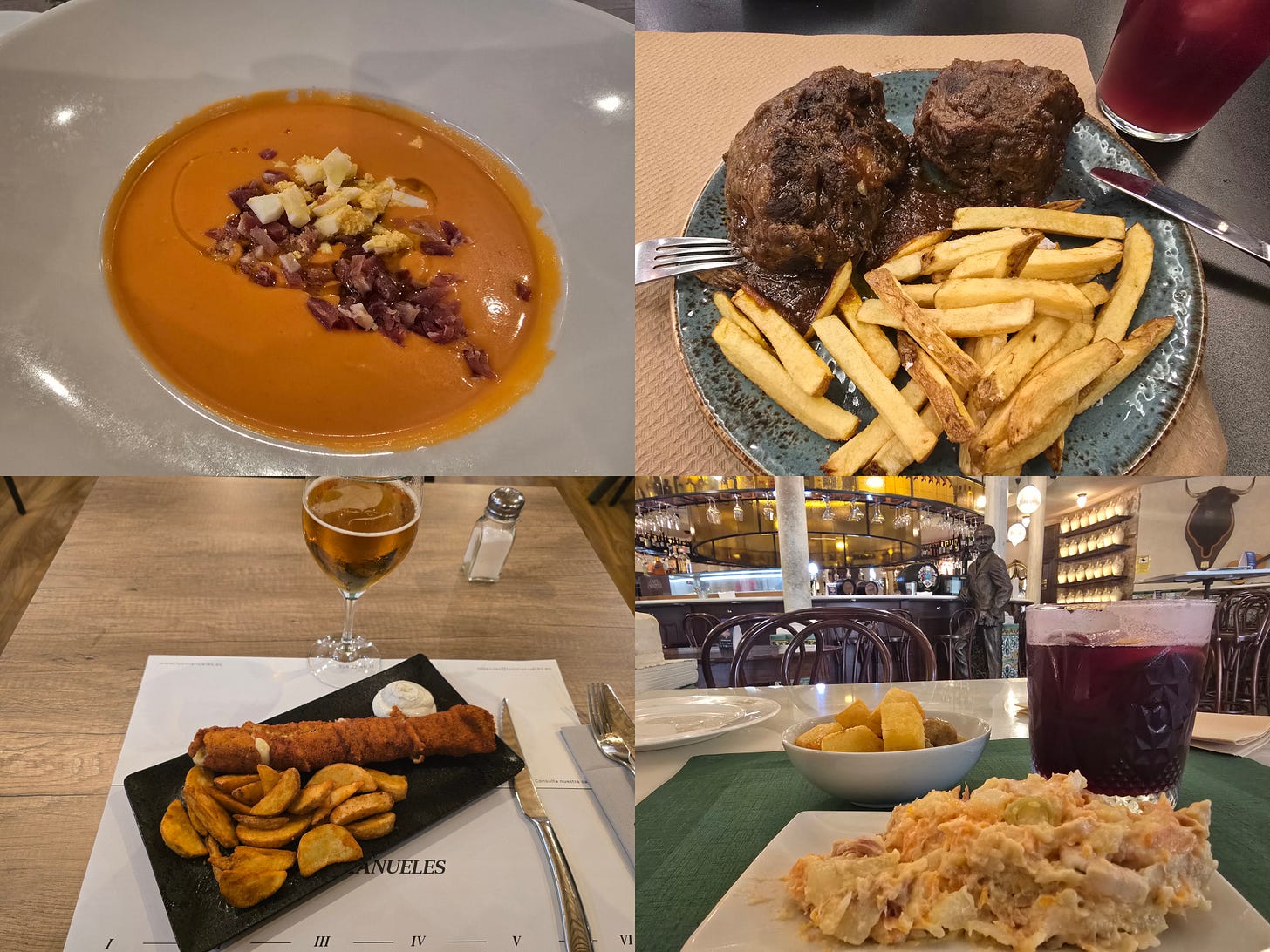
Anyhow, here’s some of the dishes I tried and some brief comments on them:
Berenjenas - Eggplants, which are often fried with chips (con fritas). I tried them in the form of an empanada street snack in Granada. Can’t complain. 6/10
Bocadillos - just their version of basic sandwiches, often with jamon and/or cheese. A sandwich is a sandwich. :| 5/10
Boquerones en vinagre - Tapa dish, anchovies in vinegar. Didn’t try. Don’t expect to be a huge fan but who knows.
Croquetas - Didn’t try, deep fried bready stuff isn’t a priority for me and it’s originally French anyway.
Ensalada rusa - I like Olivier salad, but I am very used to it in the Russian format (pickles, peas, and Doktorskaya sausage are crucial). I would assume swapping out the sausage for prawns might be an improvement but it’s just not the same without the sourness and acidity of the pickles and the texture of the peas, at least so far as I’m concerned. 6/10
Espeto - Wood-roasted sardines (the Portuguese grill it). Not a priority, didn’t try.
Flamenquin - Basically a roulade with jamon serrano wrapped in pork loin and coated in breadcrumb batter, and deep fried. Not a fan of deep fried stuff, not a fan of this in particular. German beef rouladen with vegetables and gravy are far better so far as this class of food goes. 3/10
Paella - This is primarily a Valencian dish. Not a huge fan of paella, and if I’m going to sample it, I assume it would be best to do it at the source.
Pescado frito - Didn’t try. But do I have to? Basically the ancestor of Fish & Chips, which a Portuguese Jew brought to London in mid-19C. (Yes, a ton of our foodways and “ancient cultural traditions” are far more recent and artificial than normies imagine. For instance, the standardized “Full English Breakfast” was basically an early 20C commercial creation).
Pionono - Small savory pastry. Nothing special. 5/10
Pistachio cake - This is more Middle Eastern cuisine it, esp. with ice cream. 9/10
Rabo de toro (oxtail stew) - I like beef stews, you generally can’t go wrong with beef in gravy and sauces. The Andalusian version is really simple. Can’t really complain but even going with just cheap oxtail meat I’d opt for an English oxtail pudding, which also includes a sprinkling of vegetables and herbs. 6/10
Salmorejo - sort of like a gazpacho (soup of tomato infused with garlic), but usually heavier, and with jamon and eggs on top. Not a huge fan of most cold soups and this was no exception. 4/10
Tinto de verano - Very popular wine cocktail made of wine, a dash of rum, and sparkling water/soft drinks. Not classy - but it’s cheap, it’s juicy, it’s boozy. My favorite such Iberian drink in this category firmly remains Portuguese green wine (vinho verde), but I can’t complain about this at all; competitive with sangria. 8/10
Fanciest thing I got - which is obviously not specifically Andalusian or even Spanish - was this “warm cod” on a bed of beetroot infused paella with bits of seafood. This is from the Carmen de Aben Humeya restaurant at a spectacular mirador that overlooks the Alhambra in Granada. Only including it here because it looks nice, especially the foam.


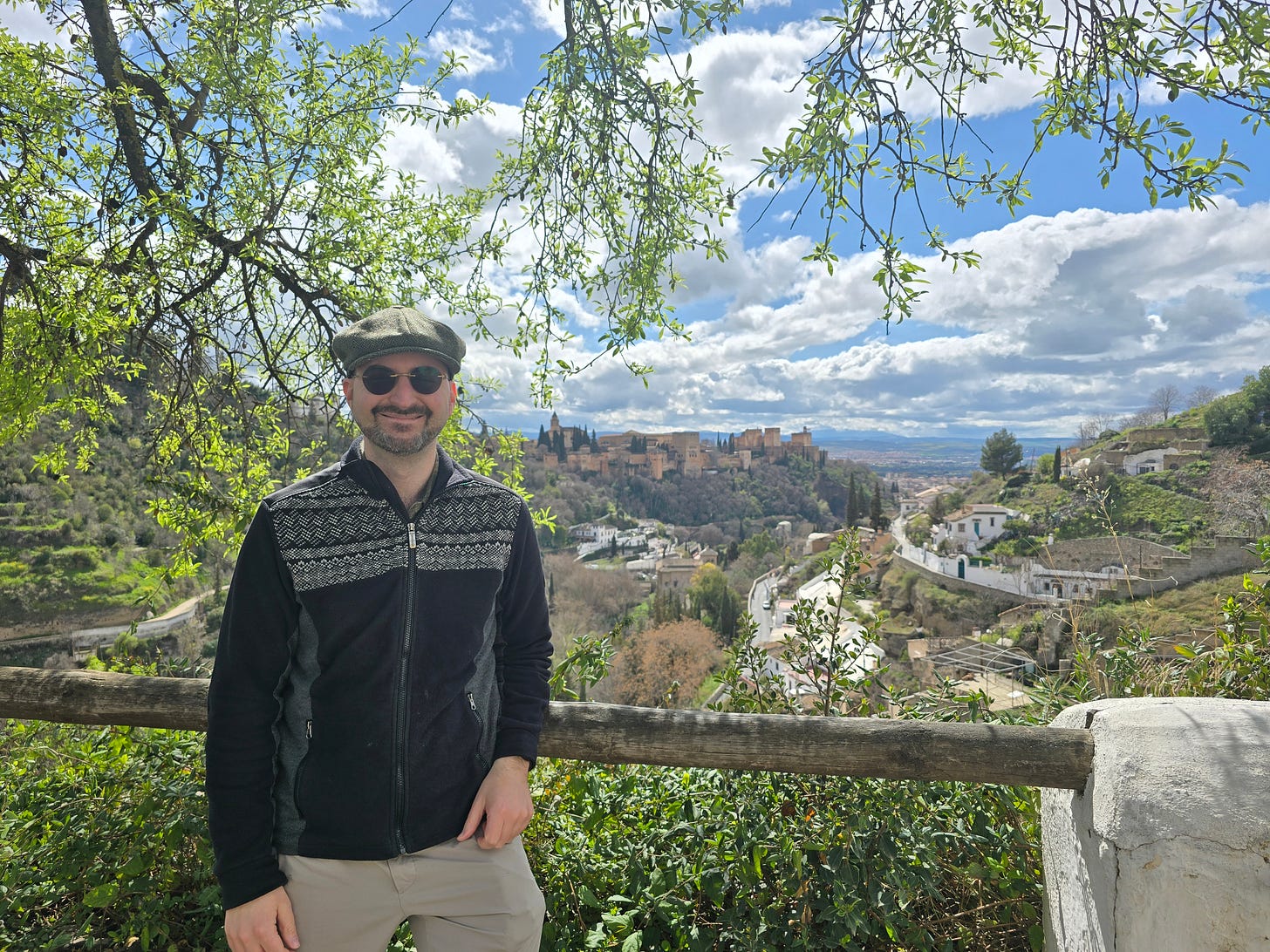
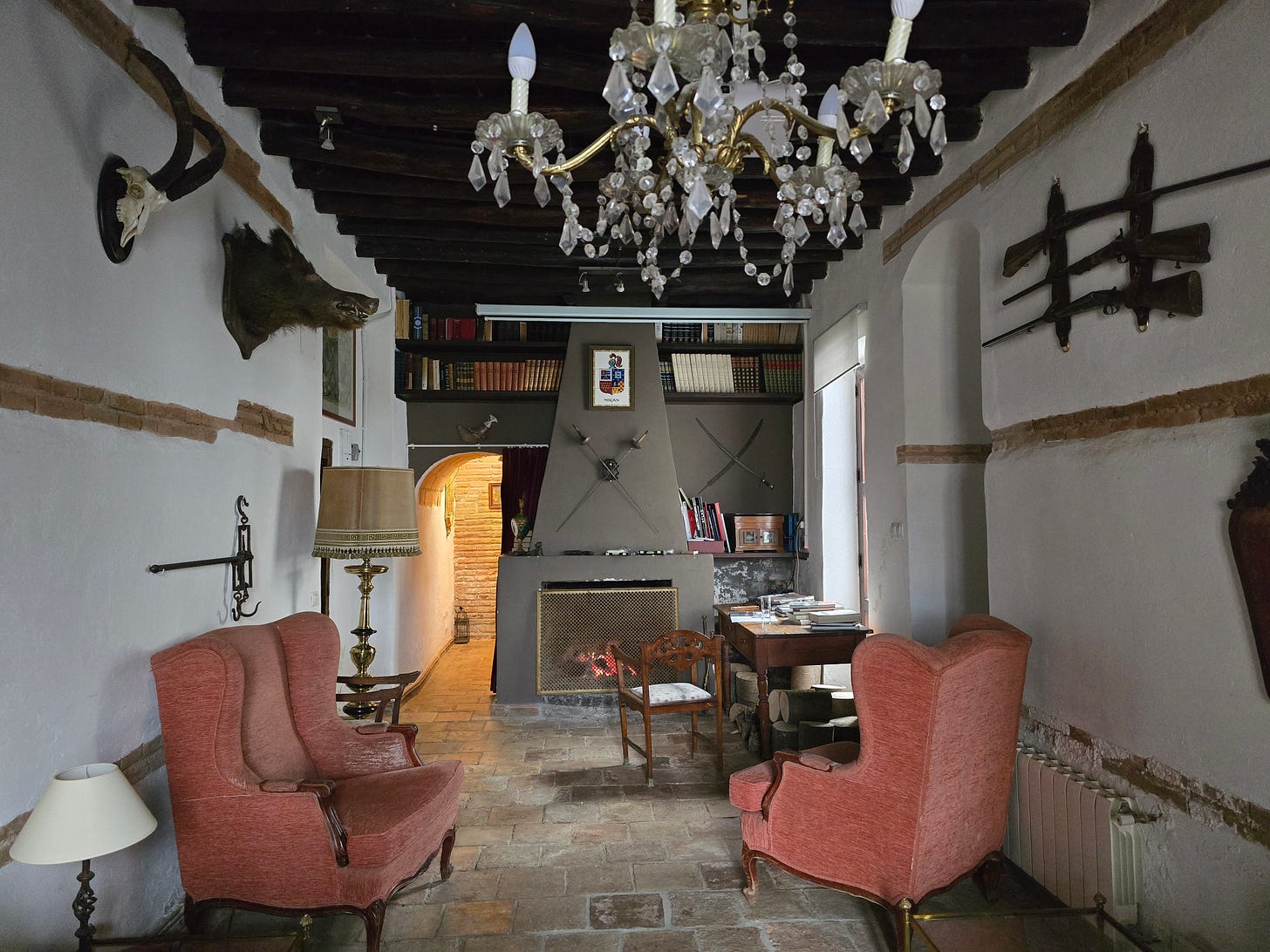
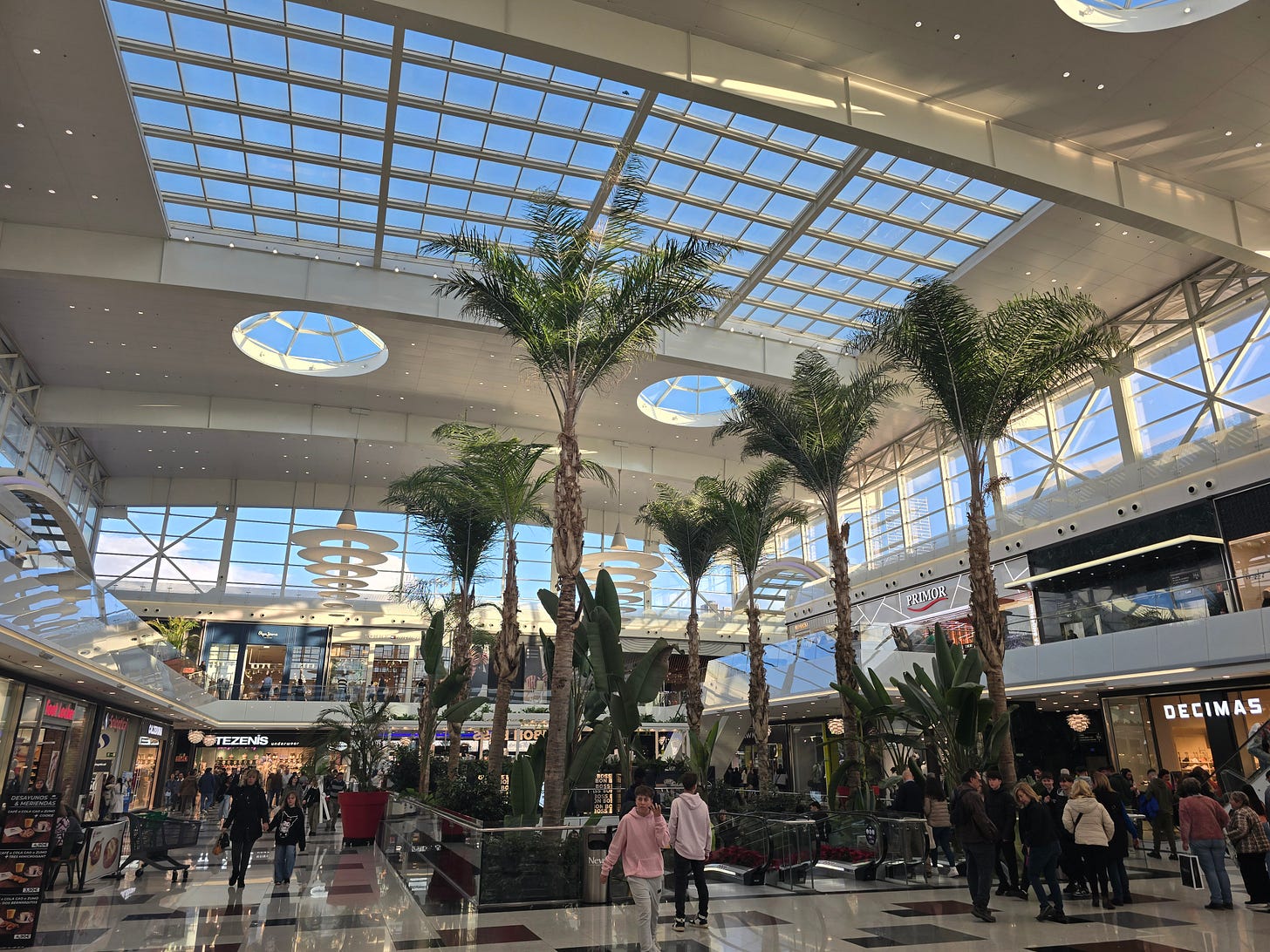




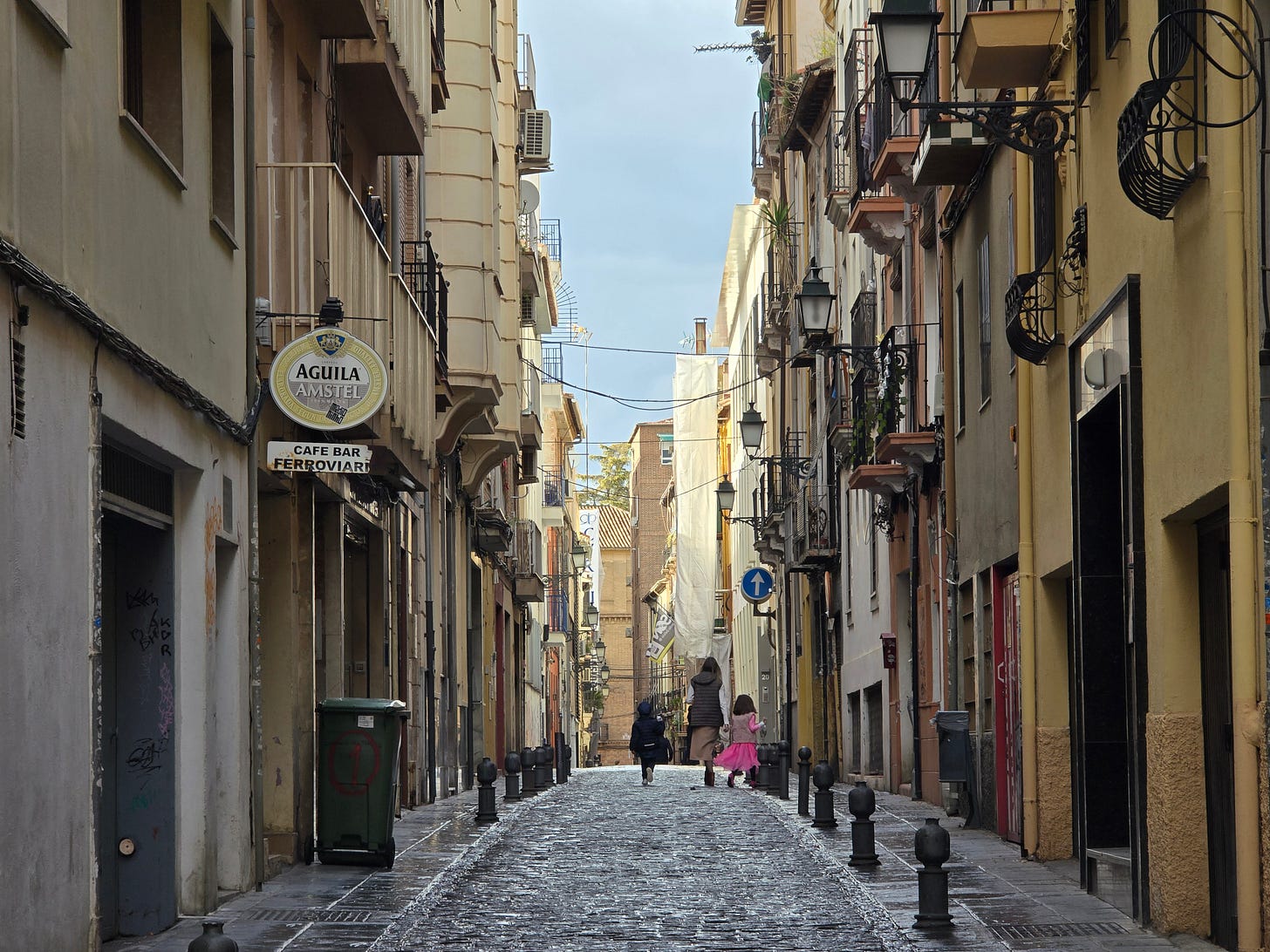
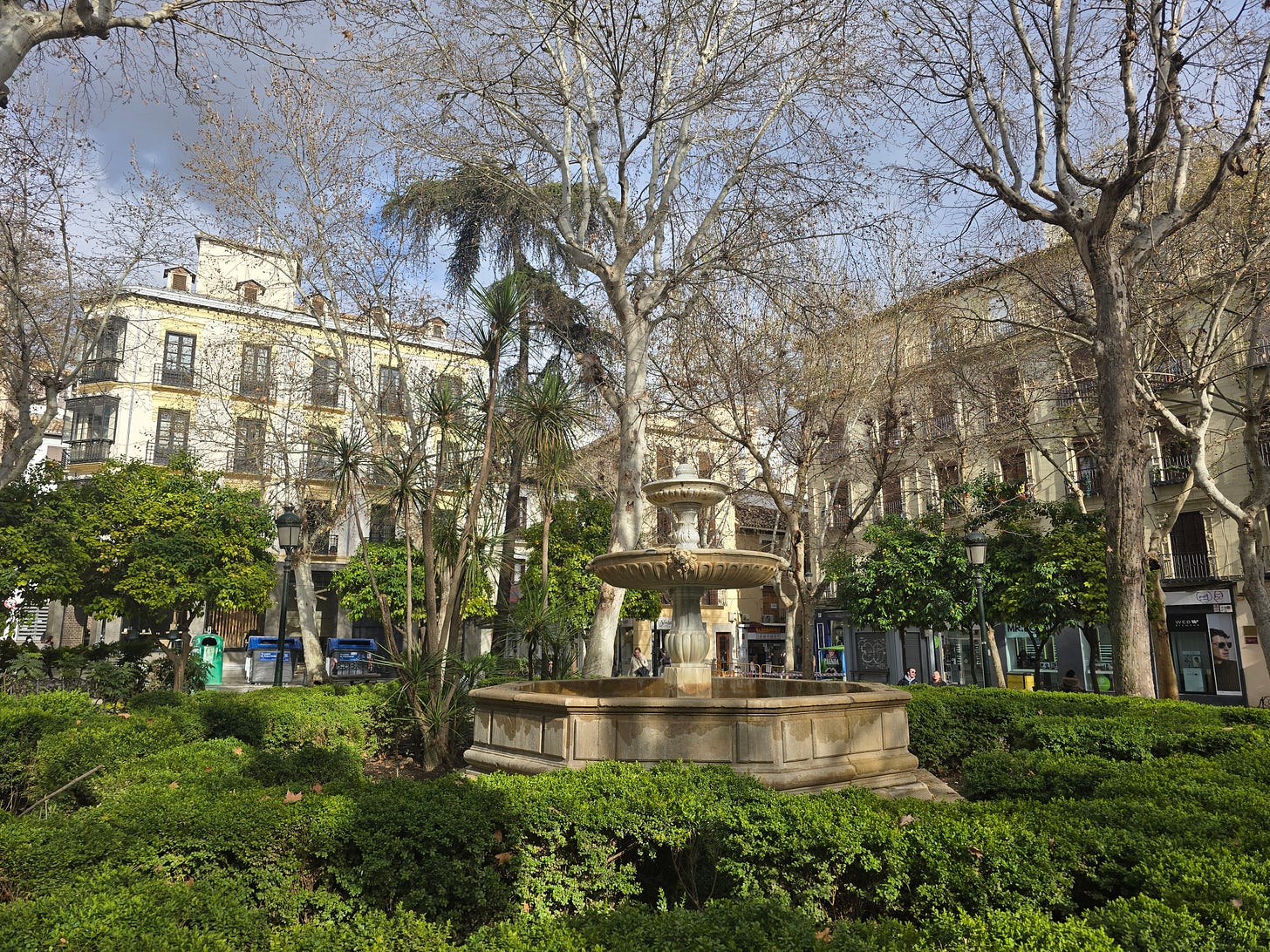
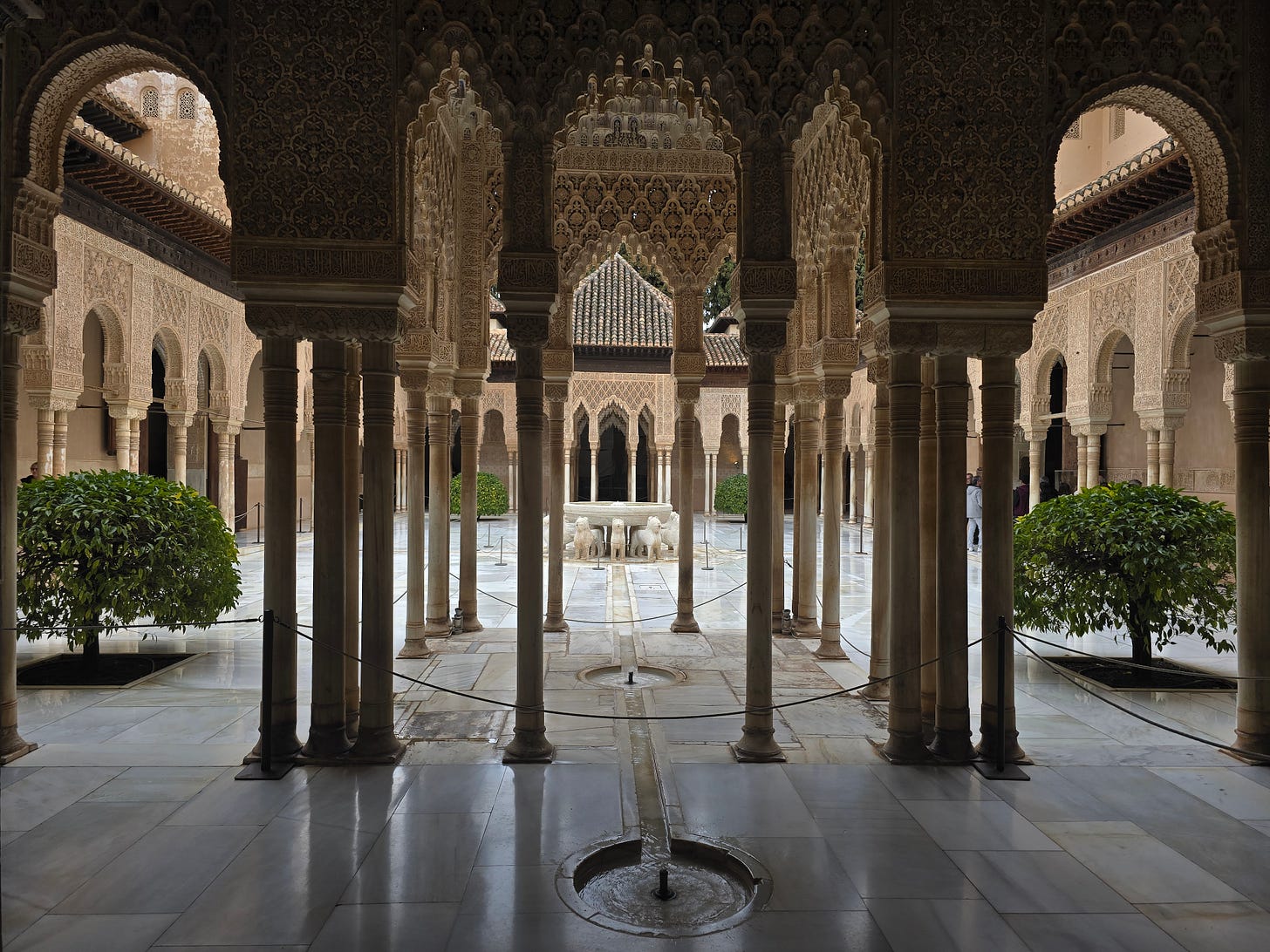

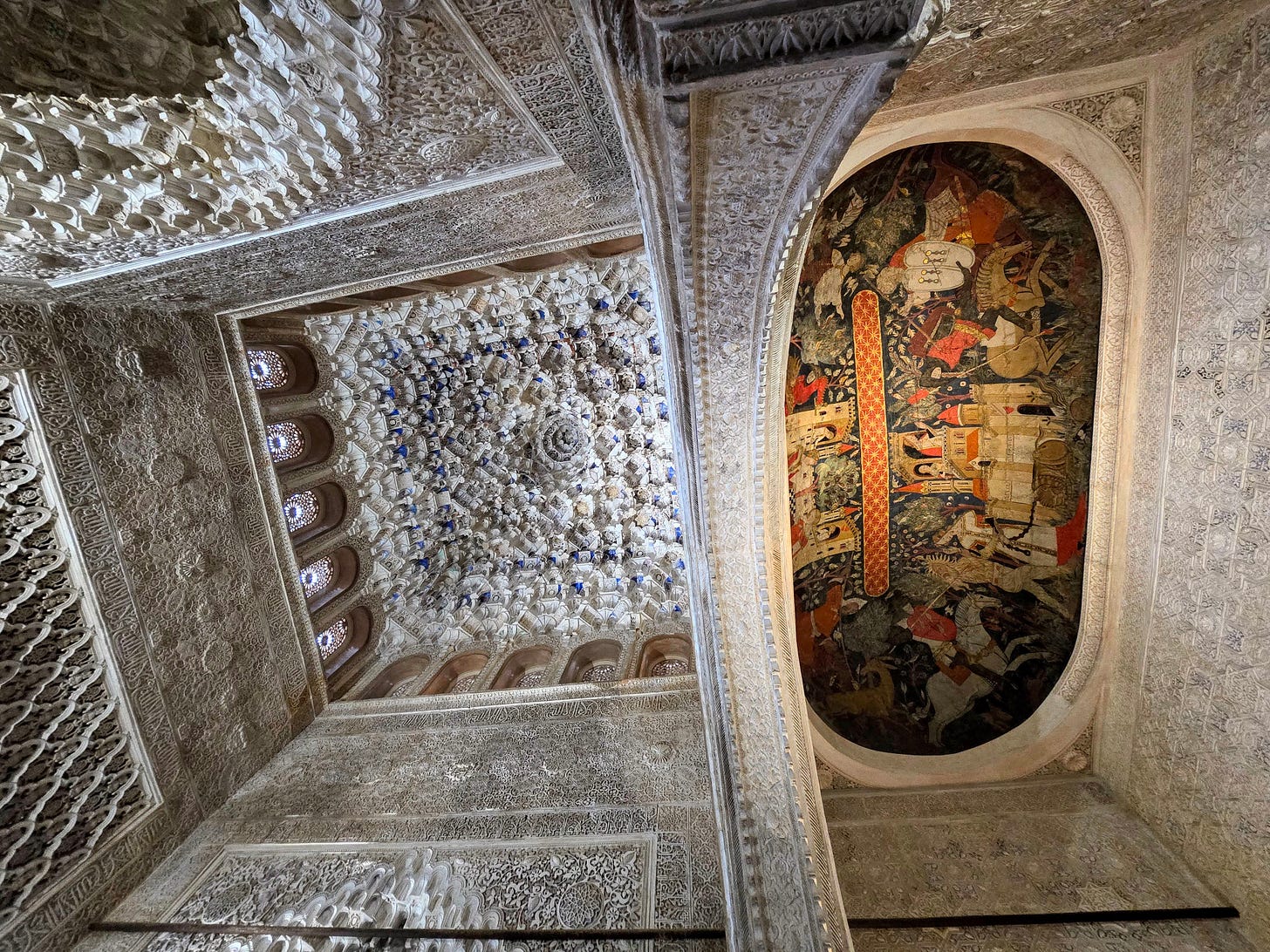
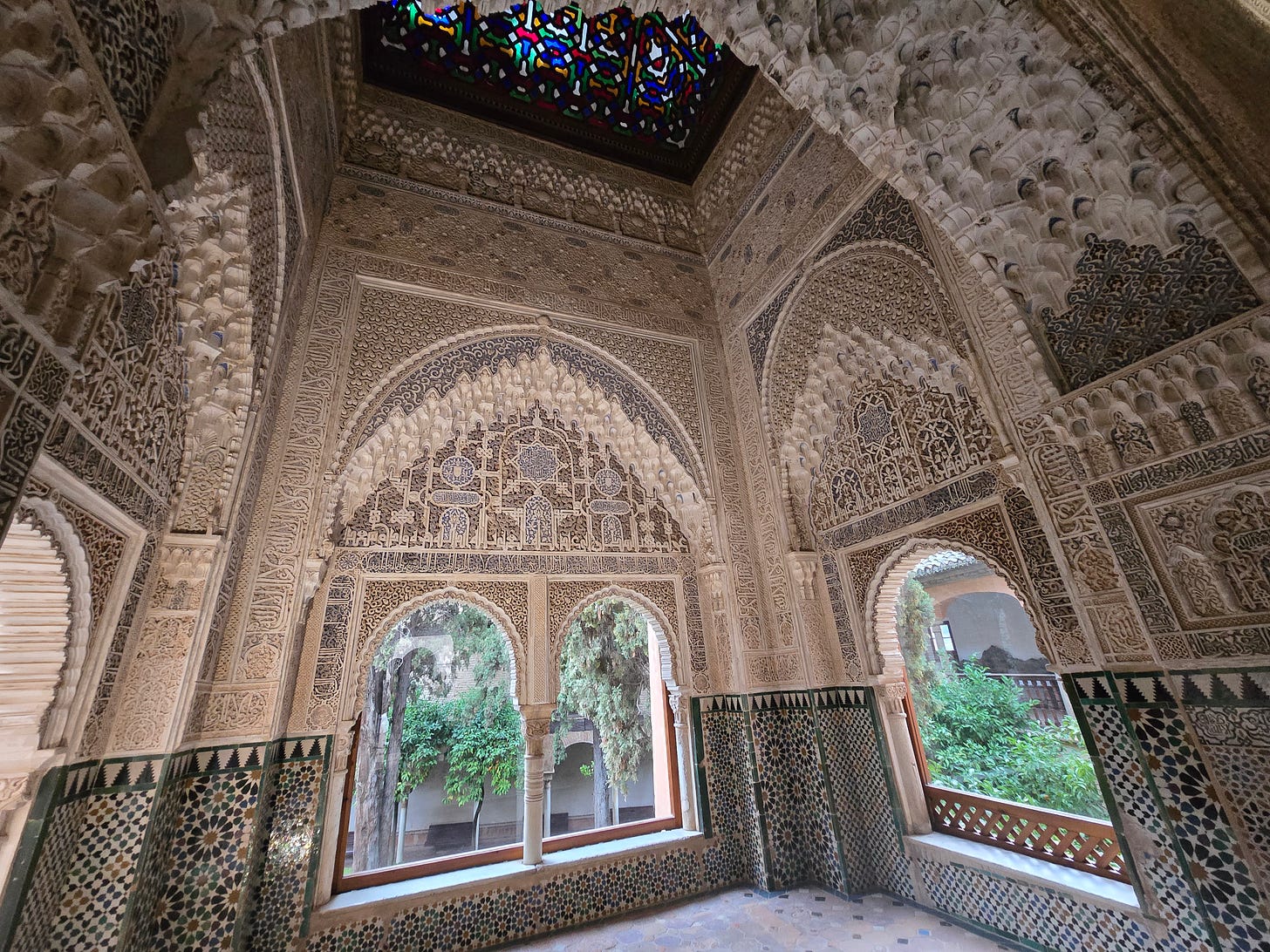




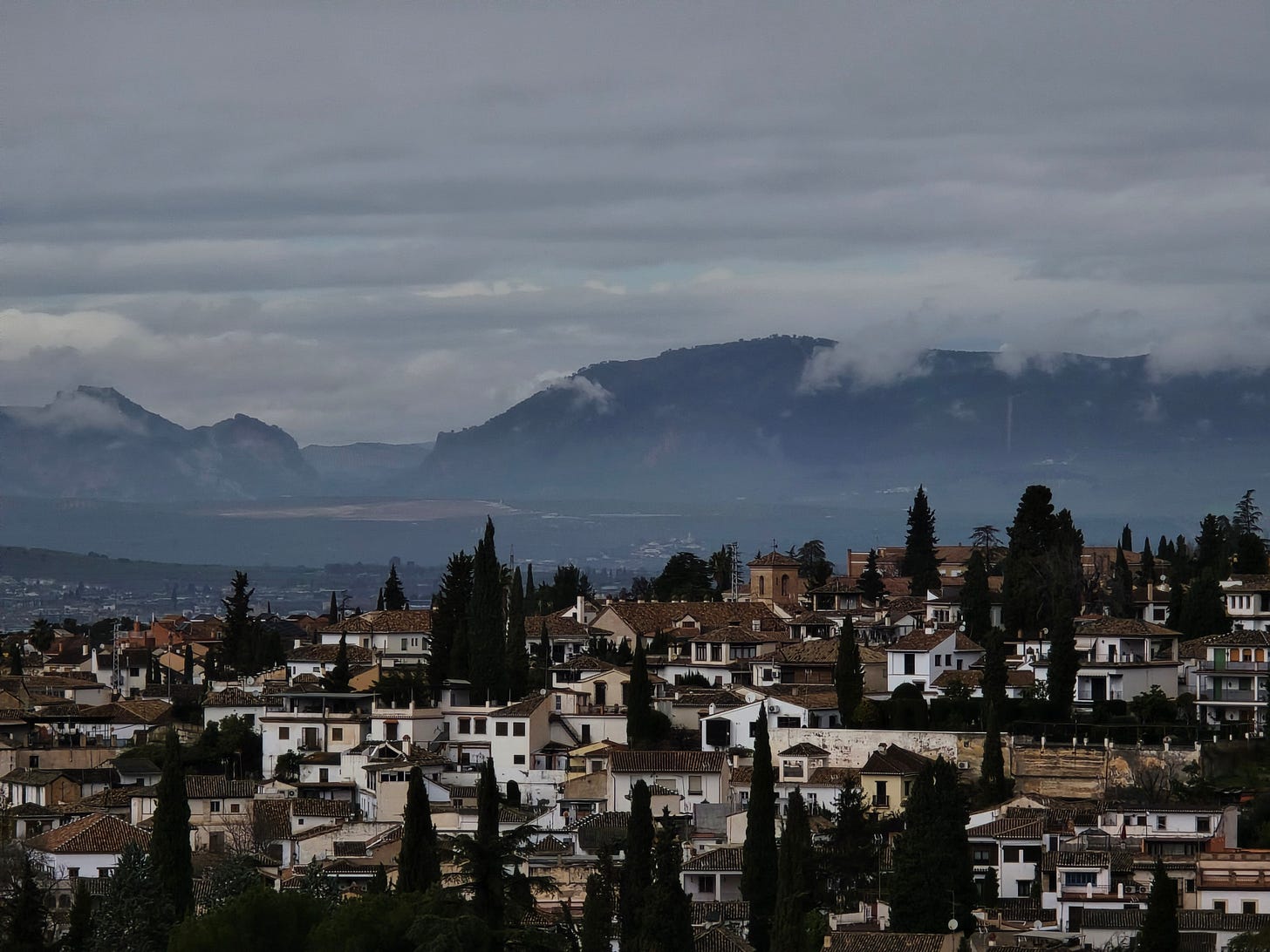


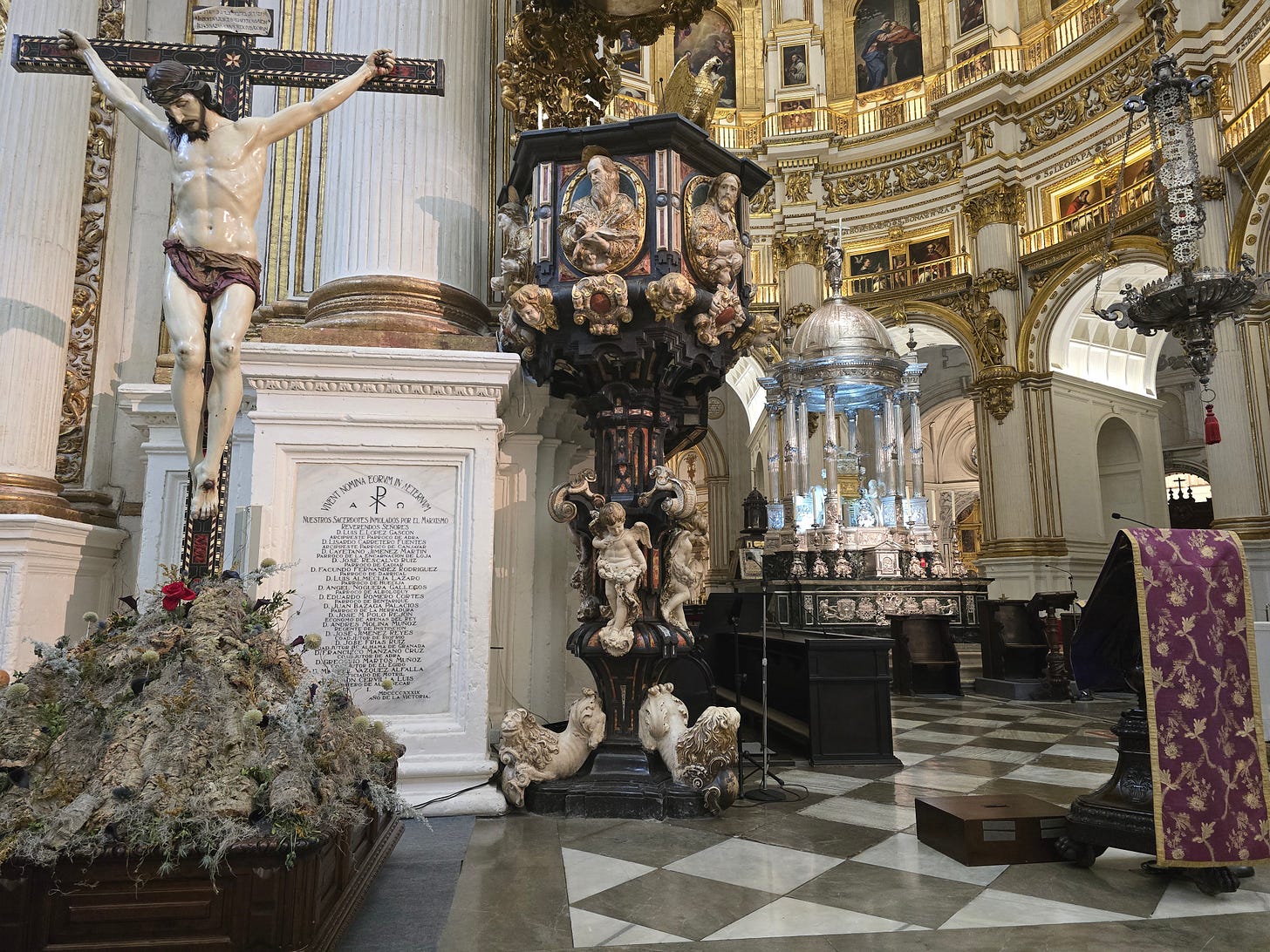
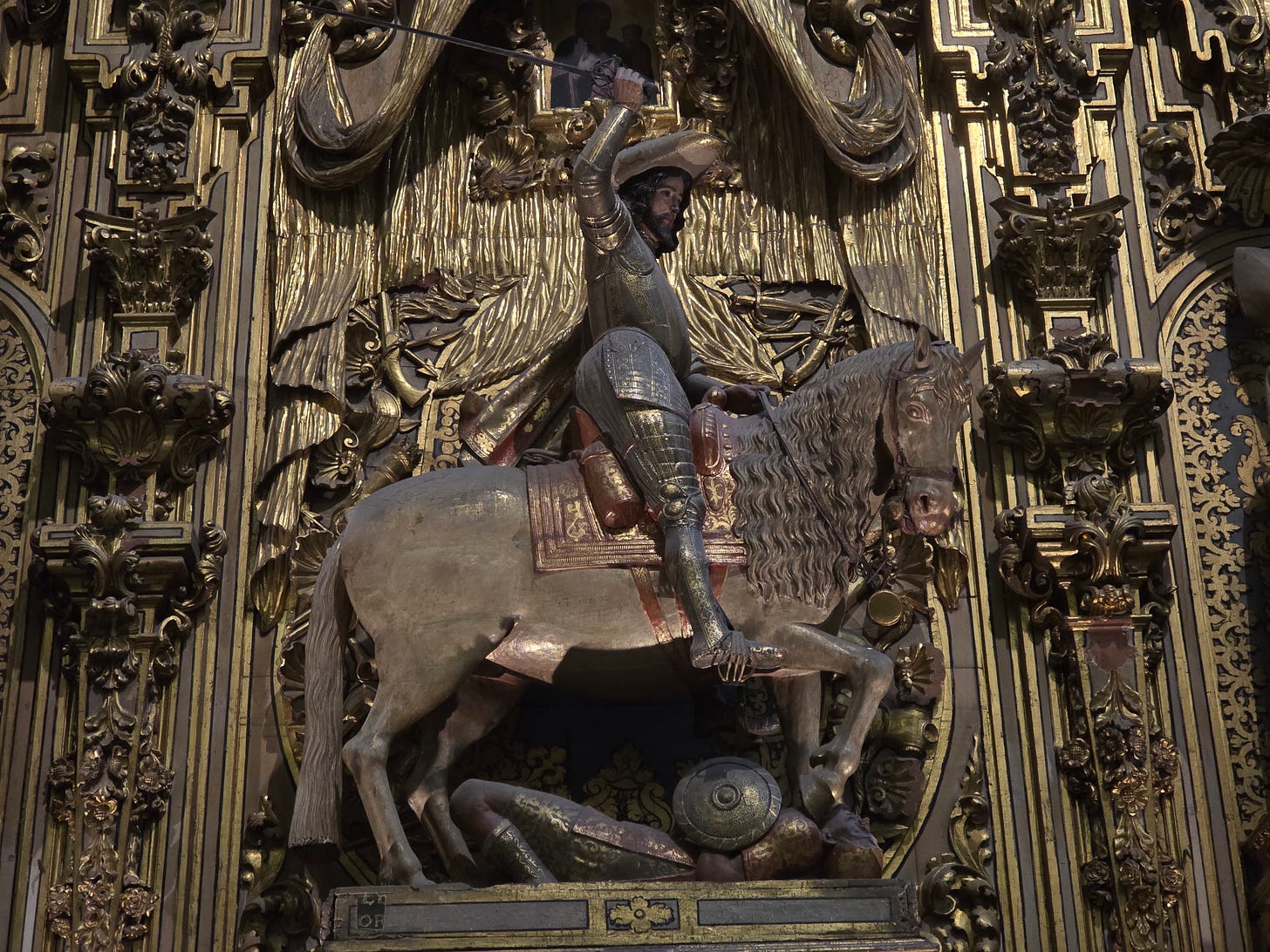
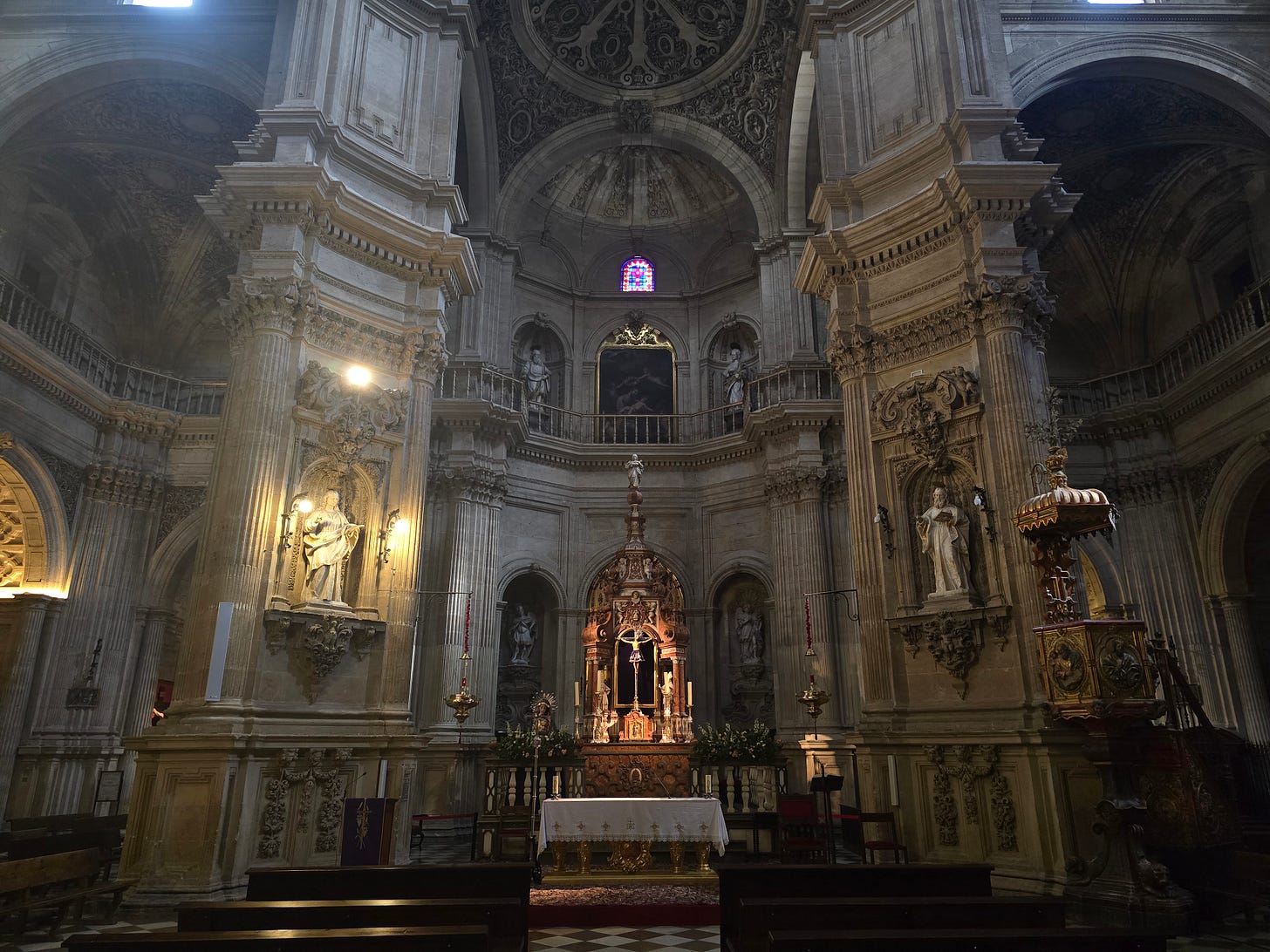



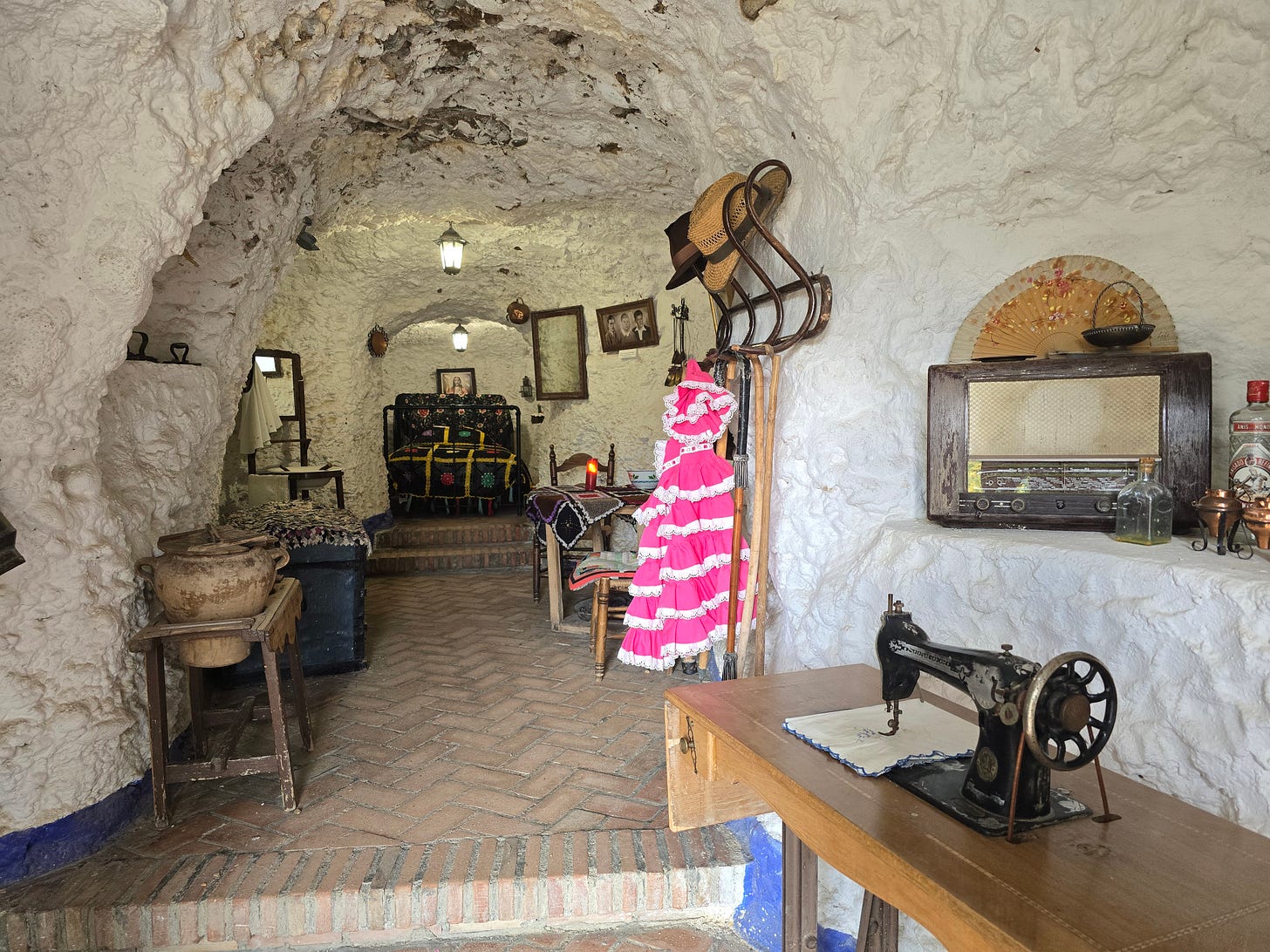

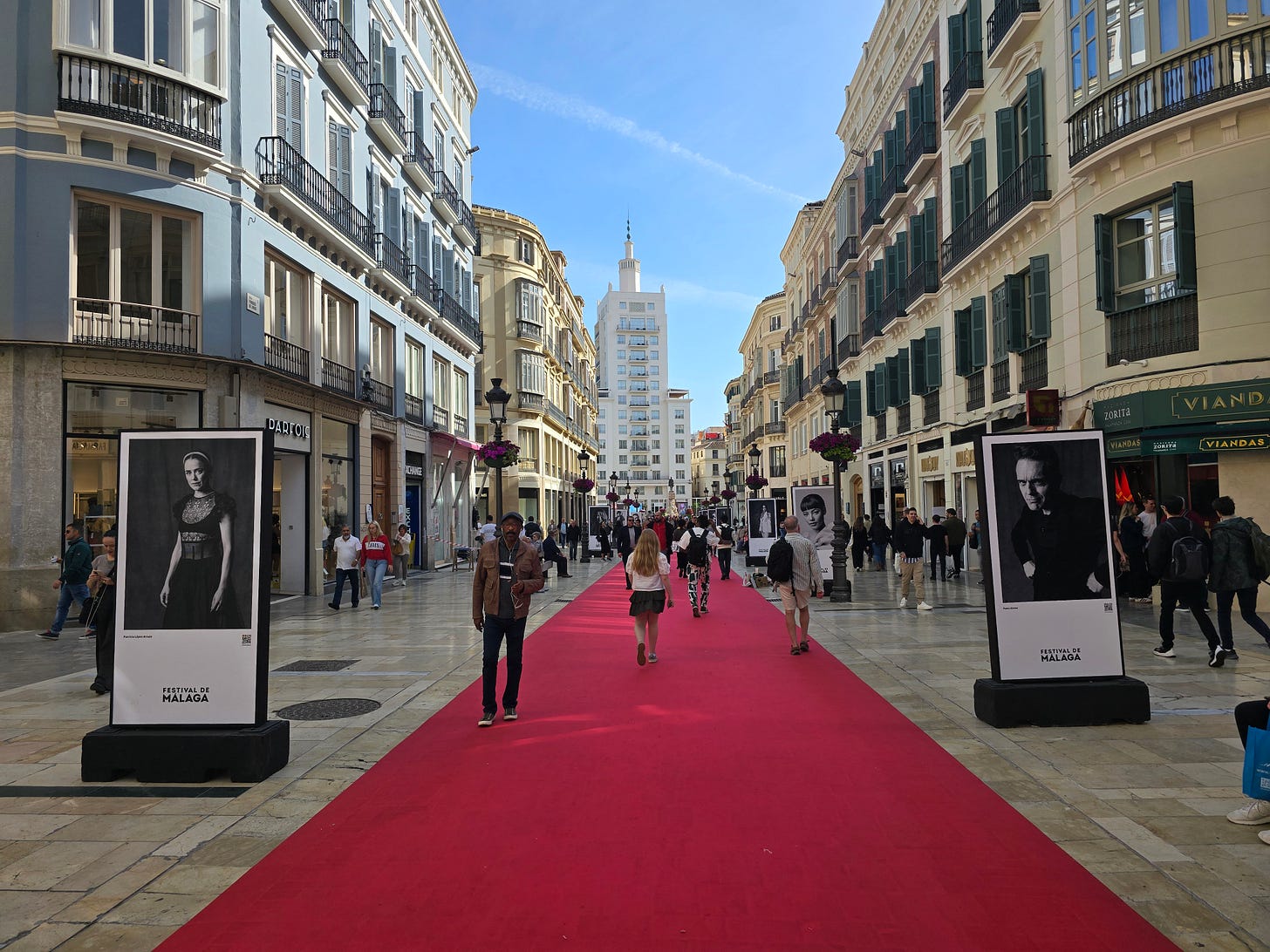

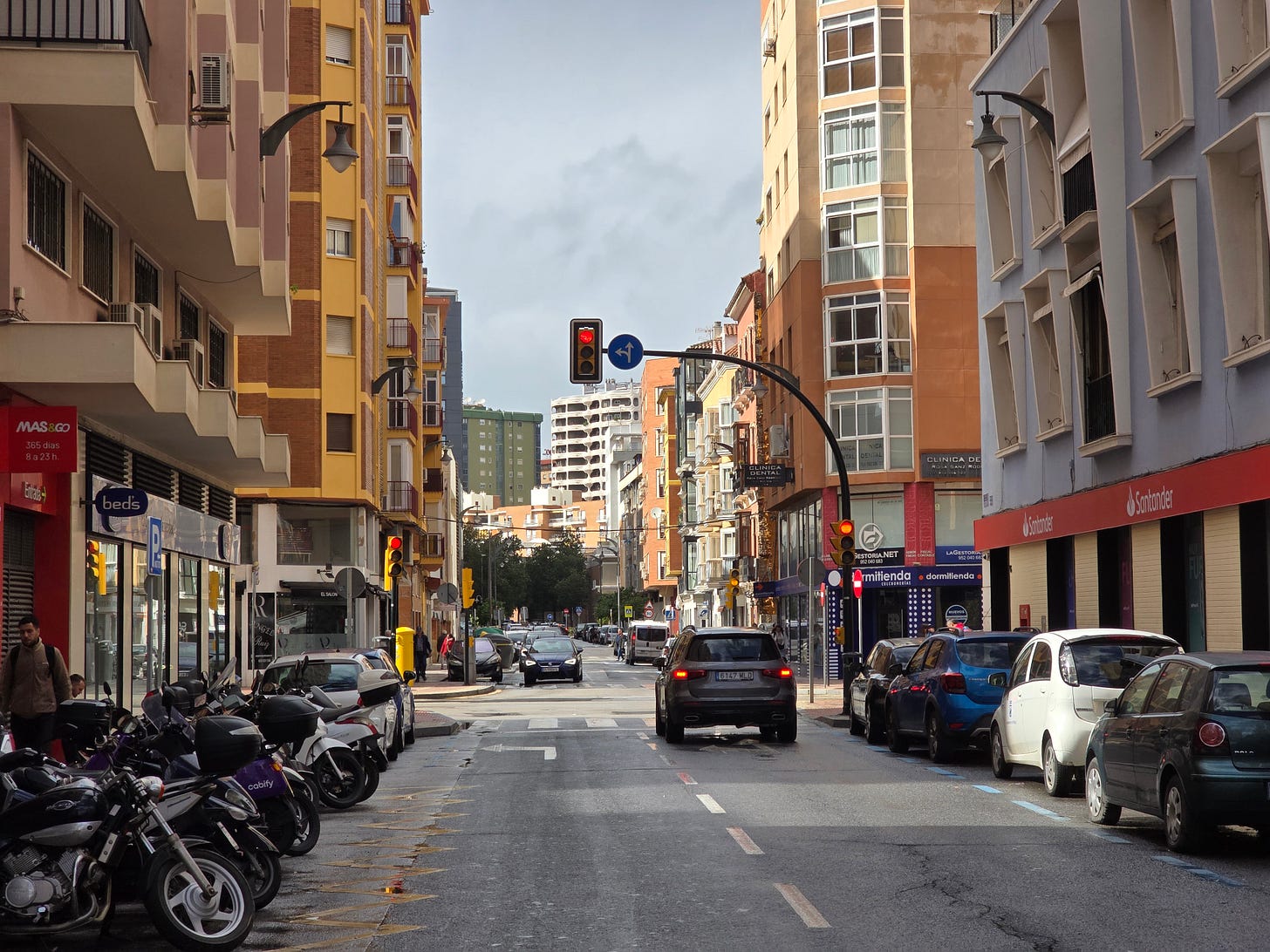
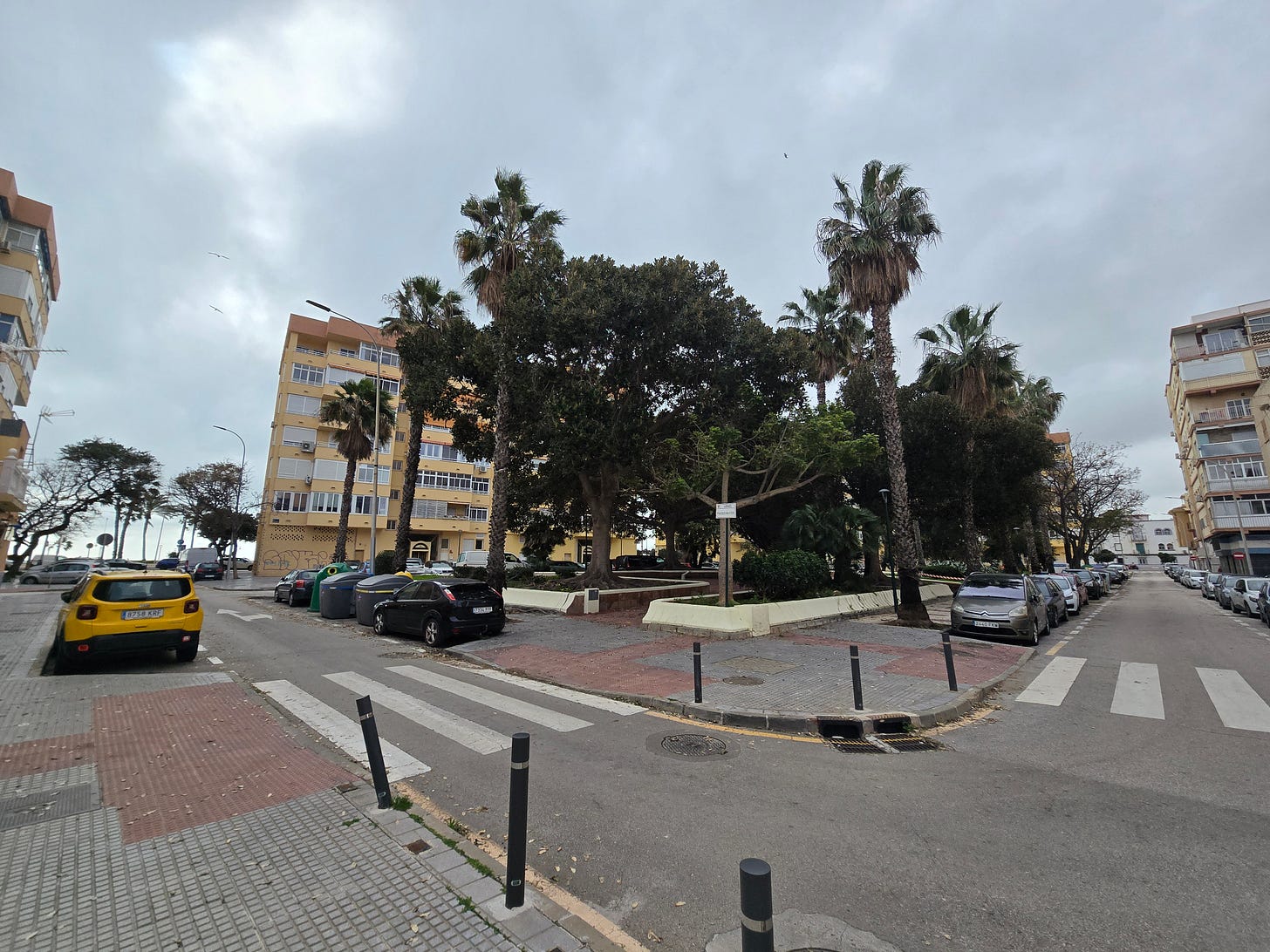
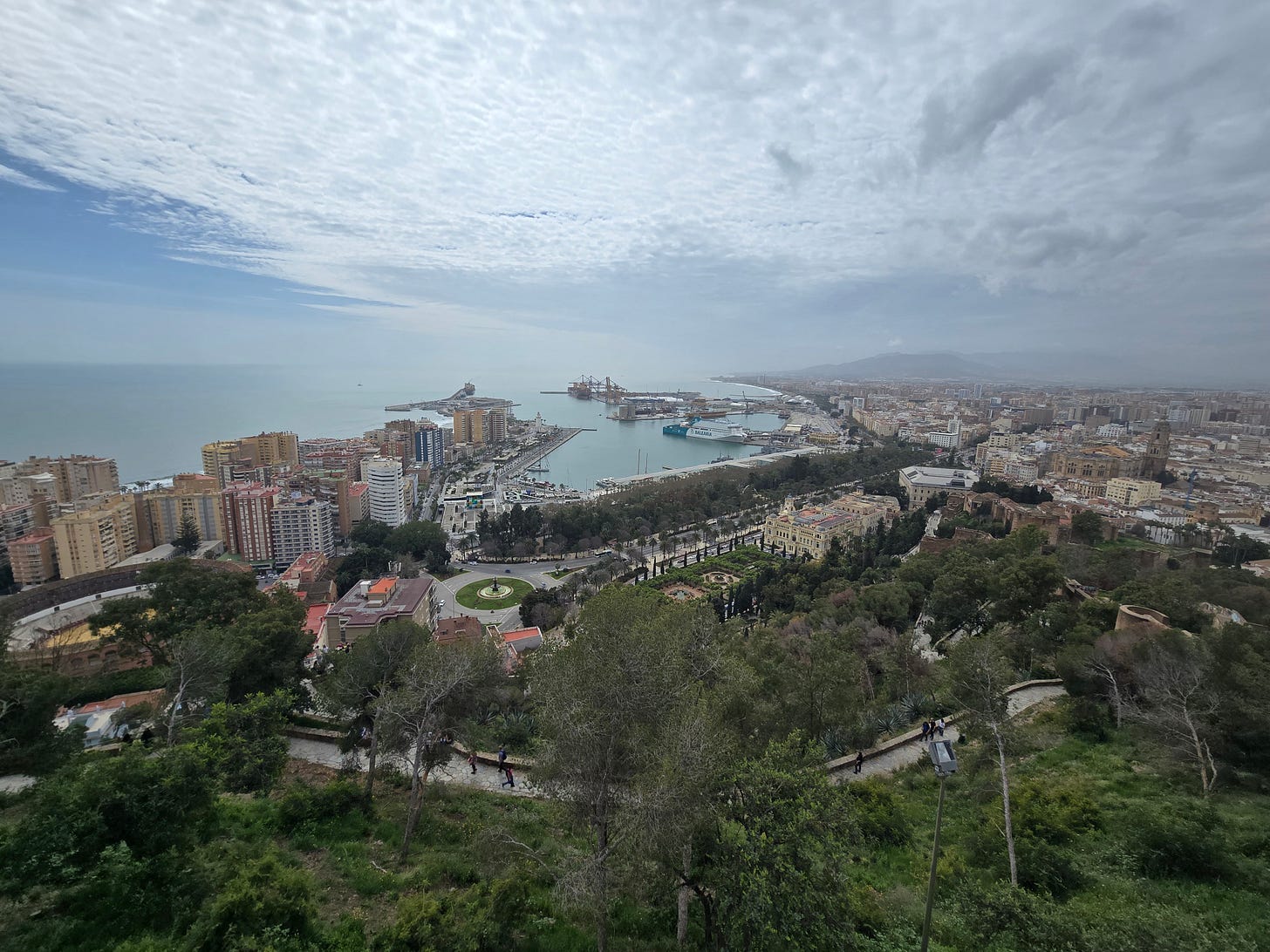

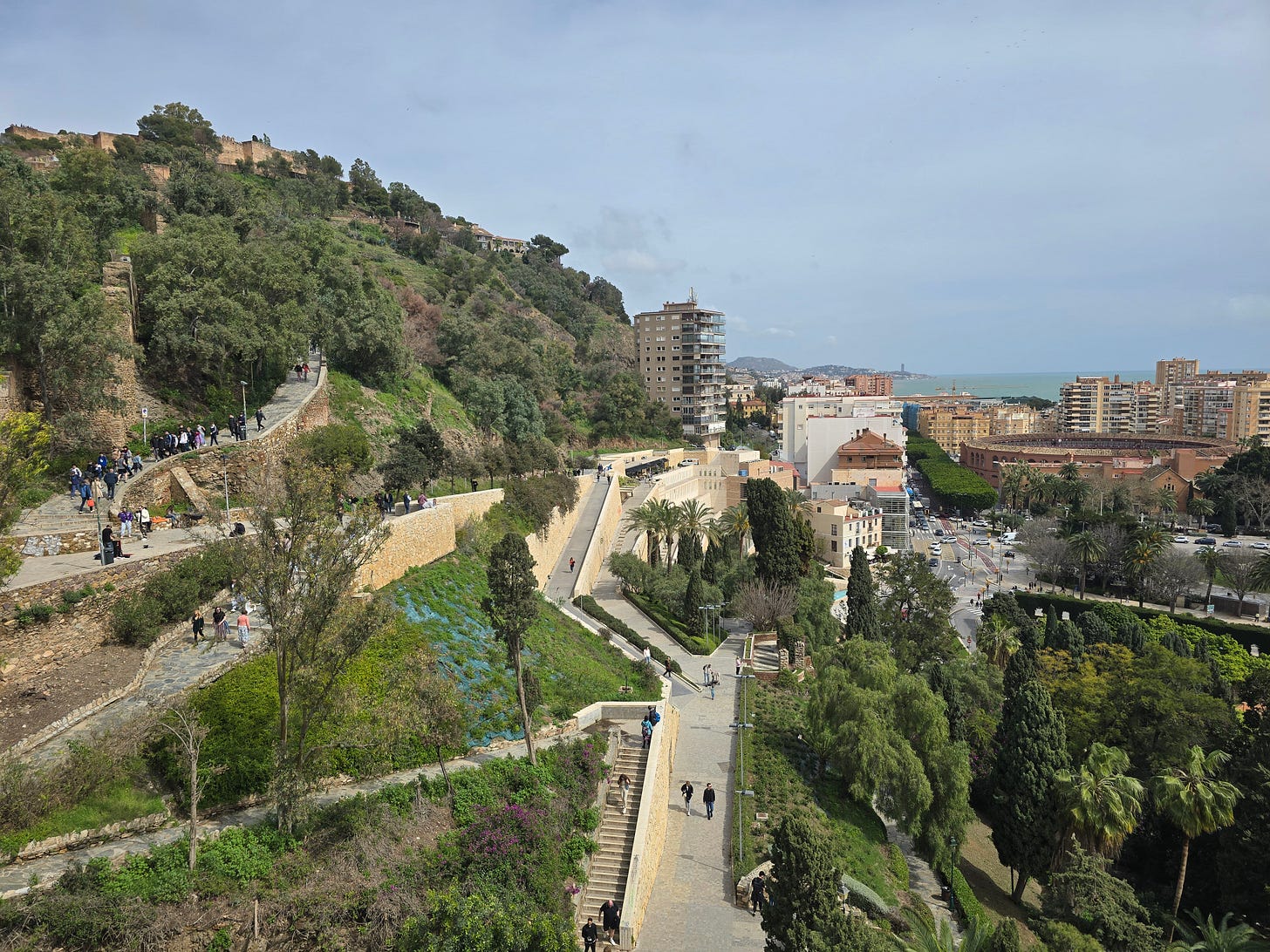
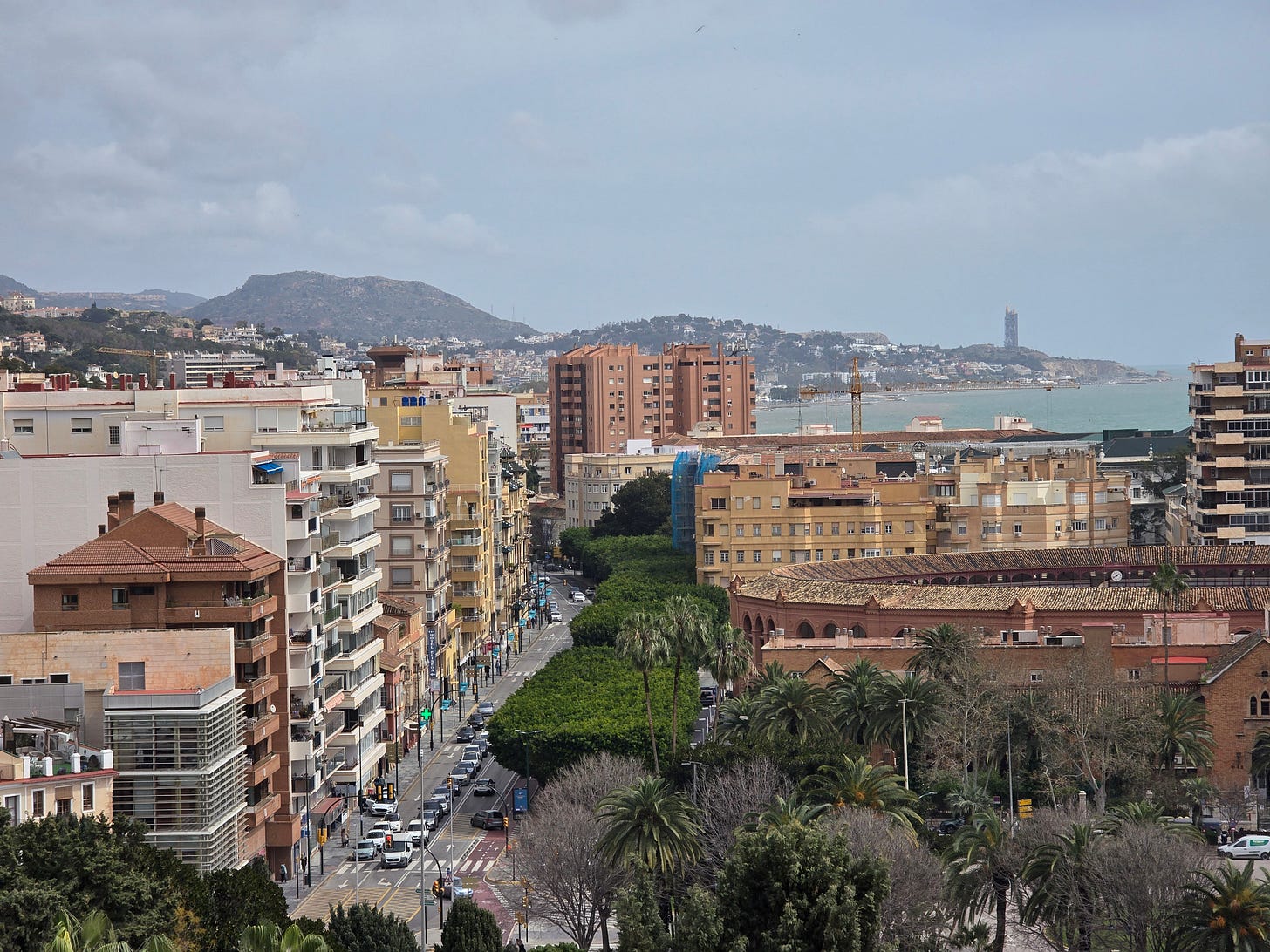
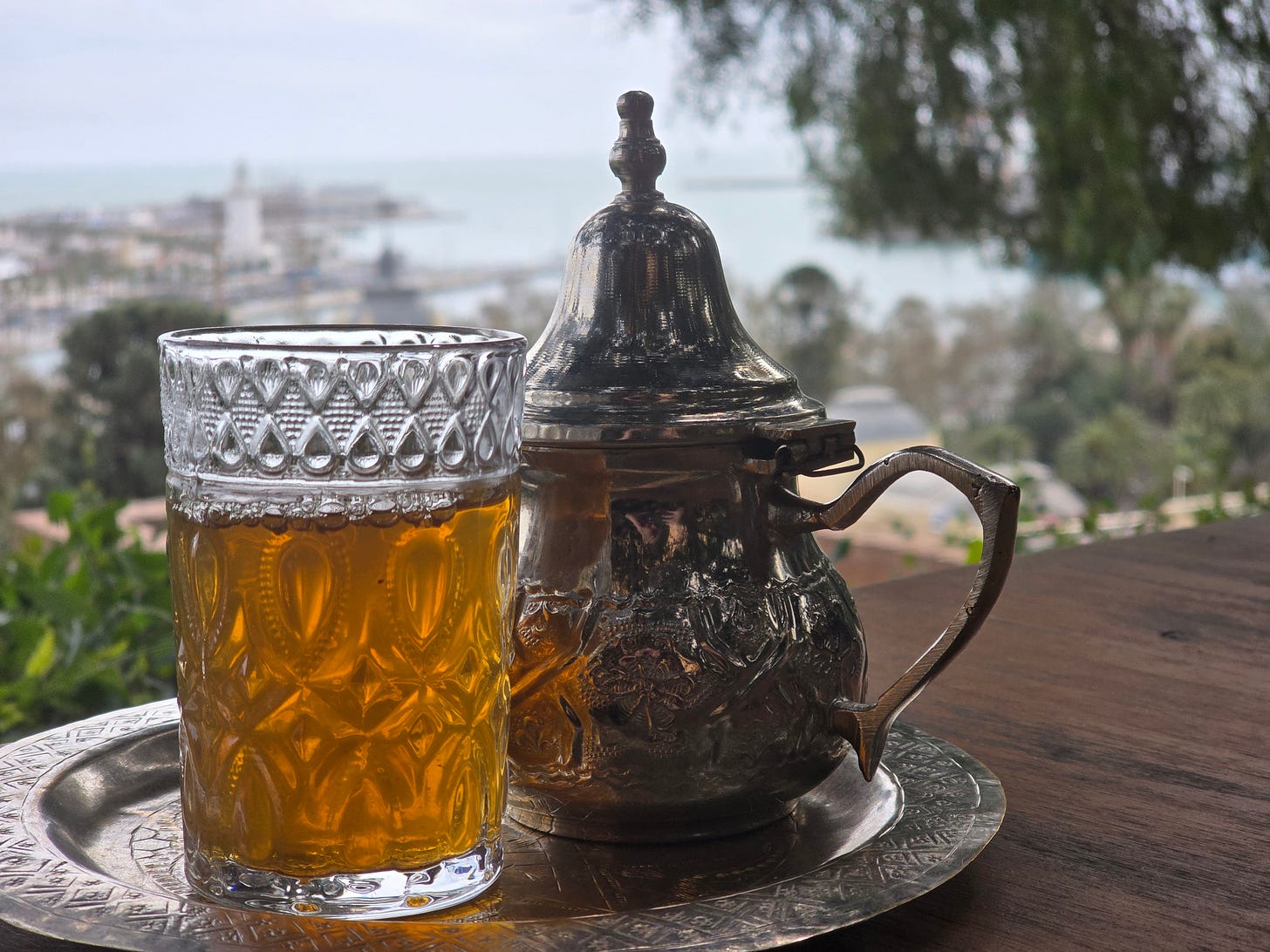
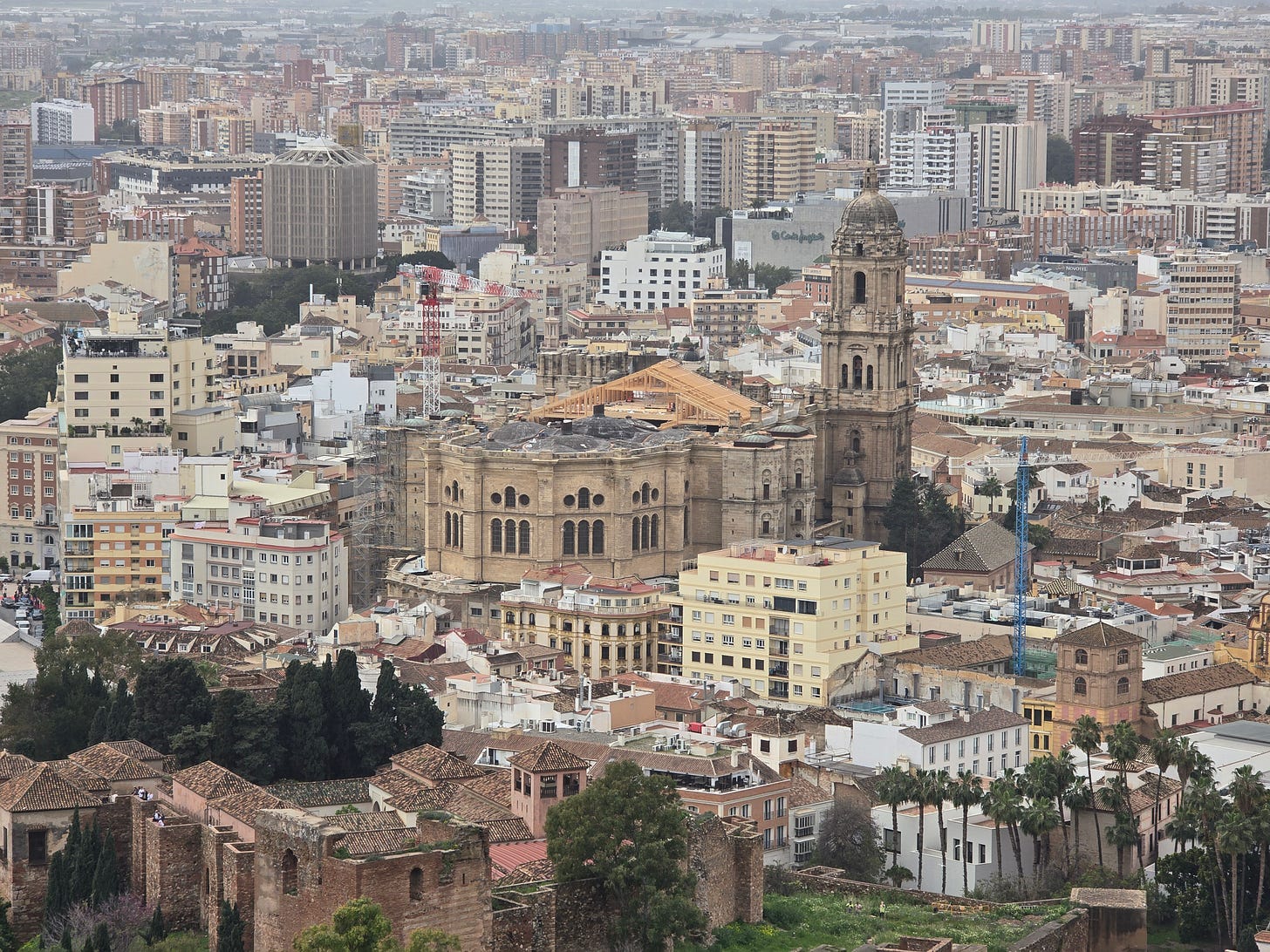

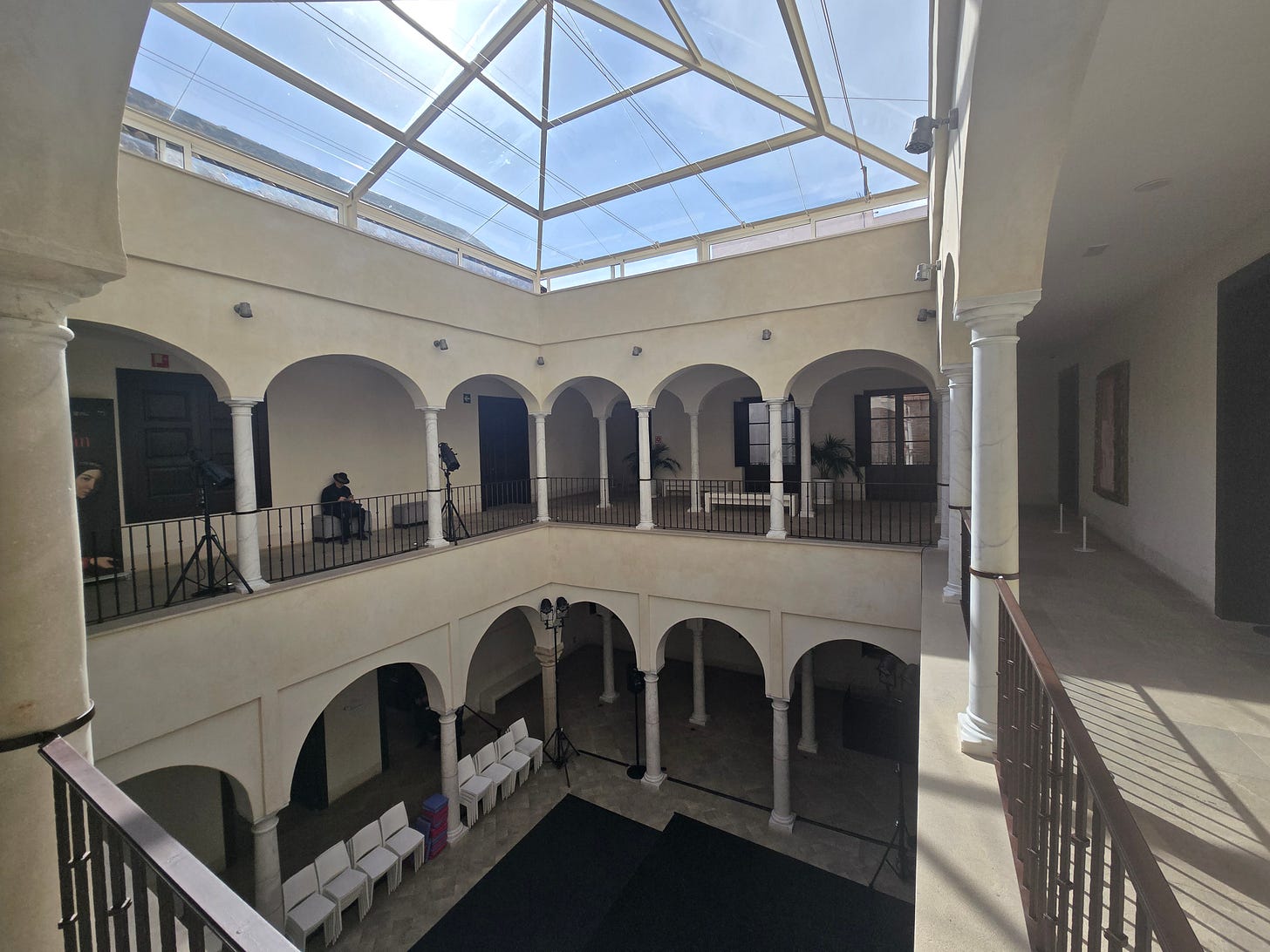


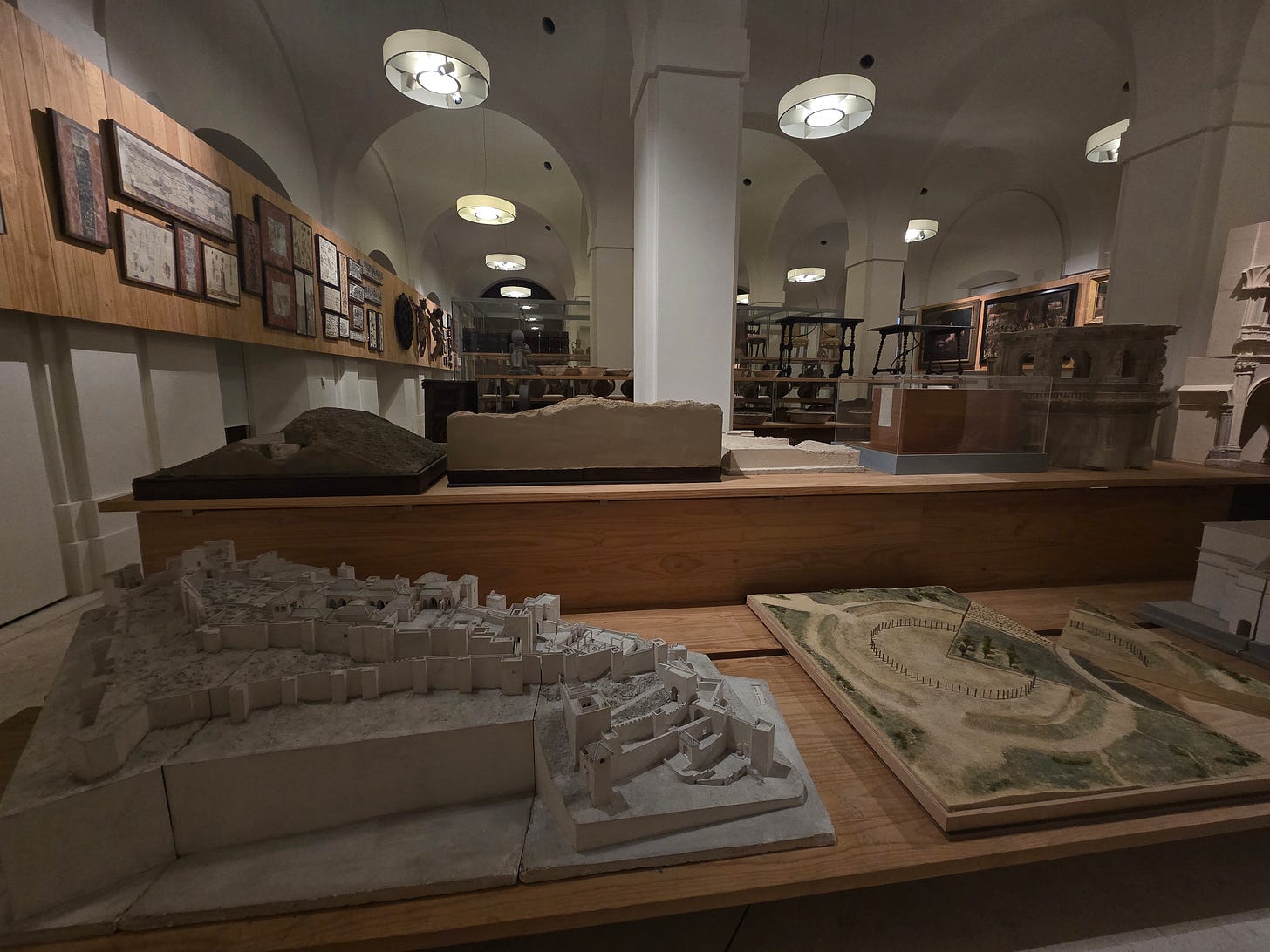



Spain’s moment of glory was financed by South American silver, not gold
Nice post, Karlin.